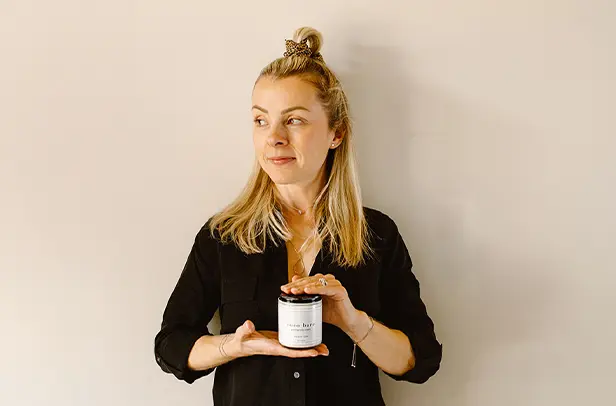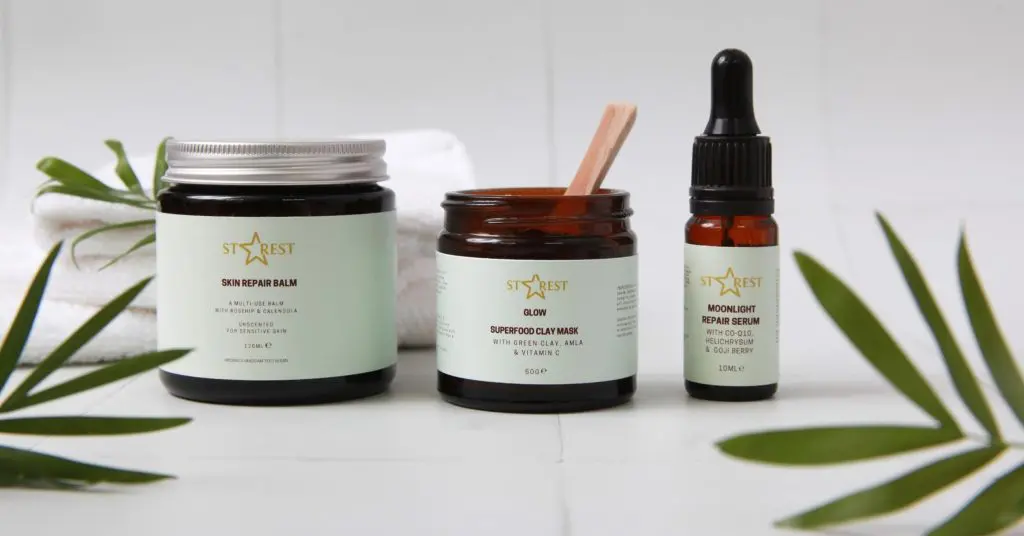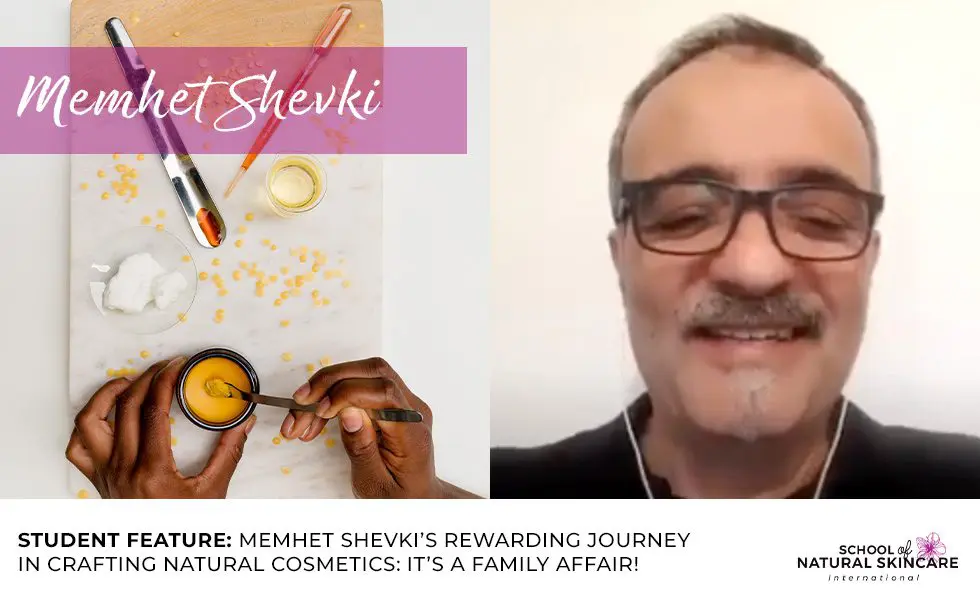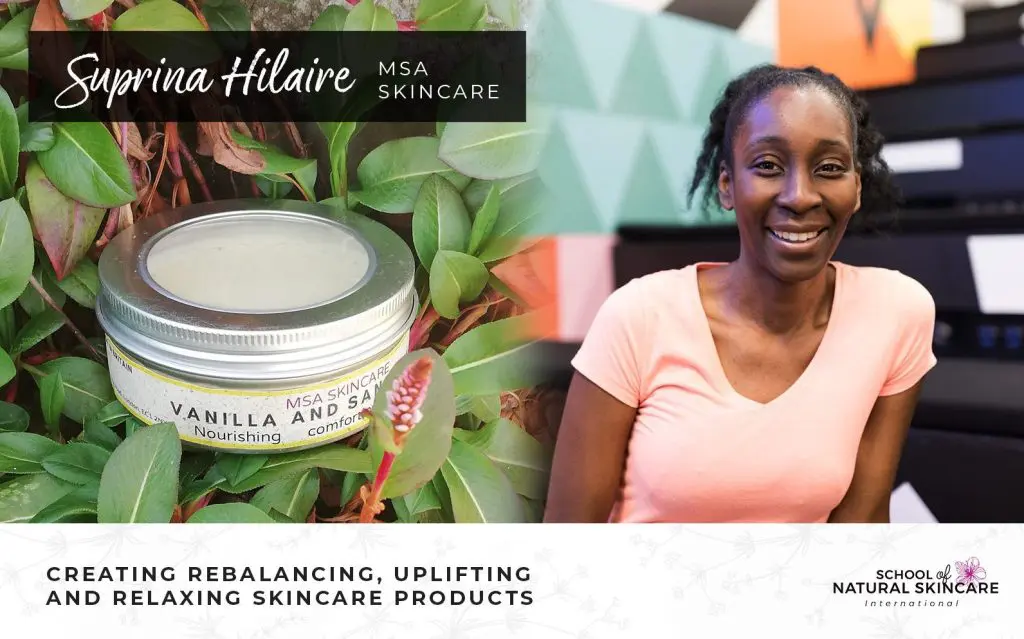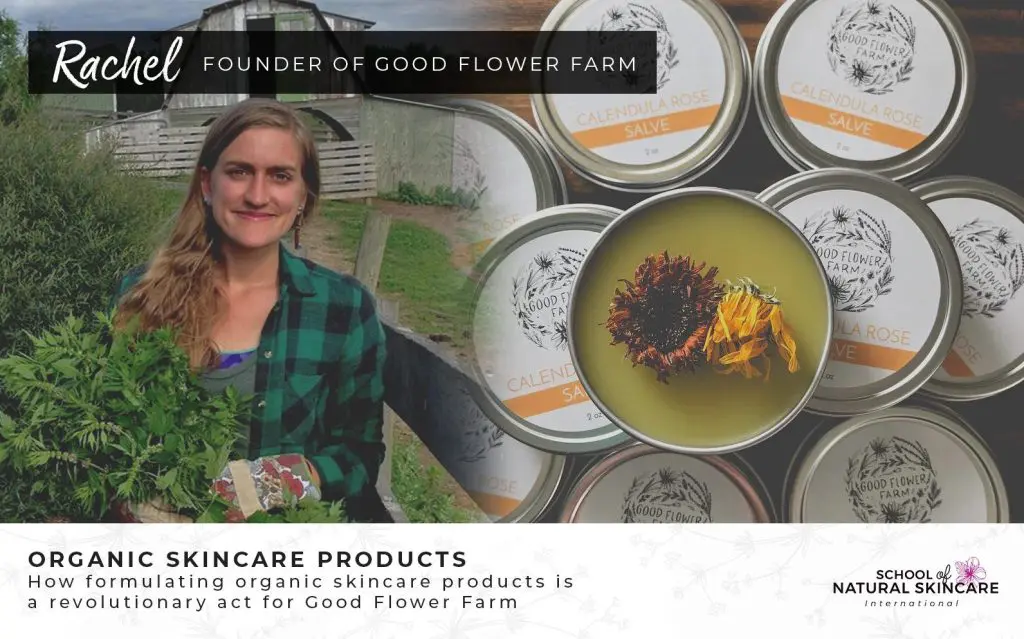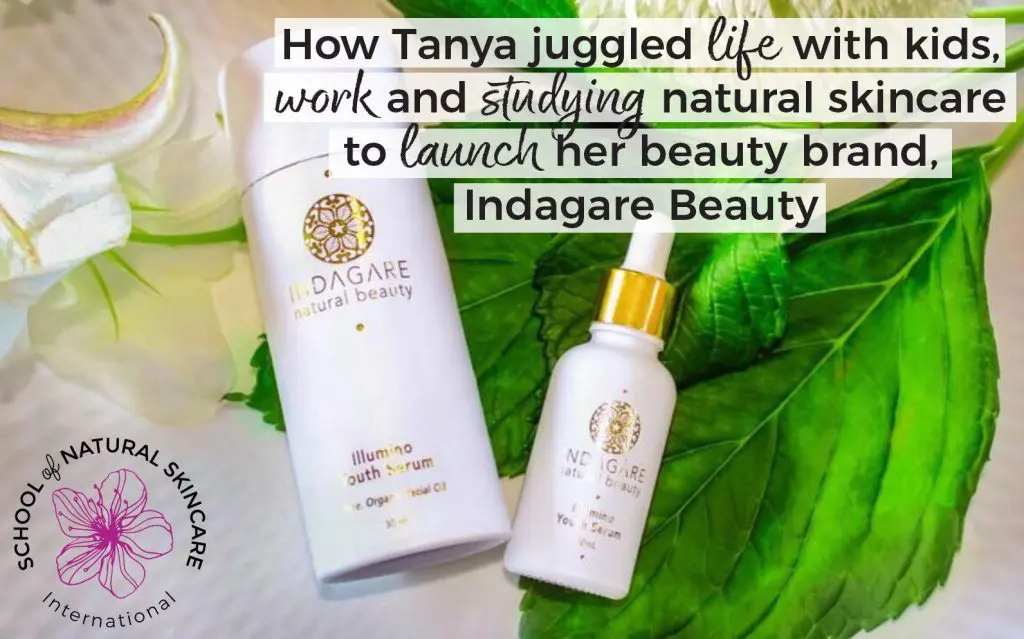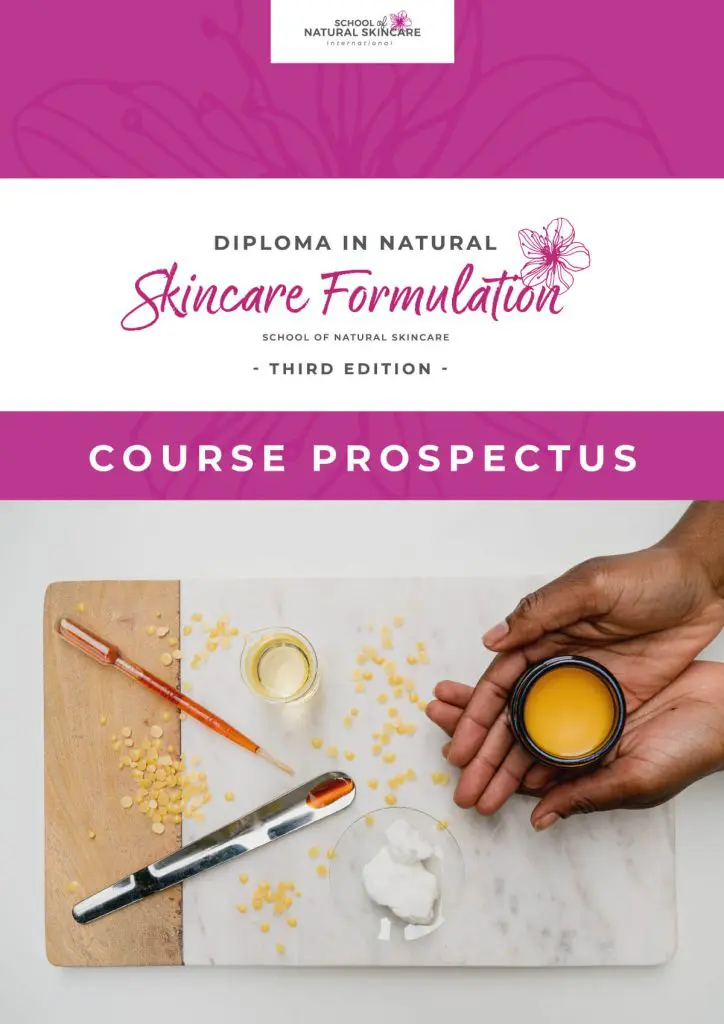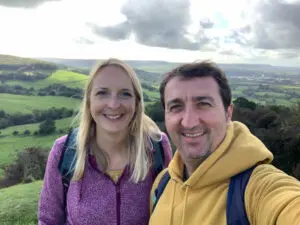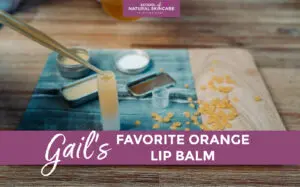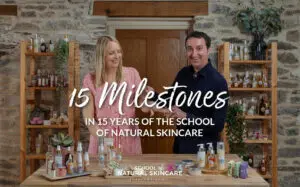Diploma in Natural Skincare Formulation
Learn to formulate your own complete range of unique, natural, or organic skincare products like a professional.
Our Diploma in Natural Skincare Formulation is the only course you need to create and launch your own skincare brand.
Are you...
Passionate about formulating your own natural skincare products but struggling to find reliable guidance online?
Confused about selecting ingredients, not sure what to choose and how much to use?
Eager to launch your own natural beauty brand and want the confidence and credibility to get started?
Introducing the Diploma in Natural Skincare Formulation
The ultimate online course for designing, formulating, and launching your own line of natural and organic beauty products.
In this comprehensive learning experience, you'll gain the skills and knowledge to:
- Formulate your own complete range of professional quality natural or organic skincare products that meet industry standards, including passing Preservation Efficacy Testing.
- Receive expert guidance and support from experienced cosmetic scientists and chemists.
- Transform your passion for skincare into a thriving business venture by:
- Crafting your brand’s vision and values.
- Identifying and targeting your ideal audience.
- Developing a bespoke range of natural skincare products tailored to specific skin tones, types, and concerns.
Ready to turn your formulation dreams into a successful reality?
Join us on the journey today!
Find out more
Don’t waste time and money trying to follow misleading information online with recipes that don’t work.
Instead, learn how to select the right natural and organic ingredients for your formulations – putting you in control of what you use on your skin.
Formulate with confidence, knowing you’re learning from cosmetic scientists and industry experts, using tried-and-tested formulations that have passed Preservative Efficacy Testing.
Just imagine how good it would feel if you could:
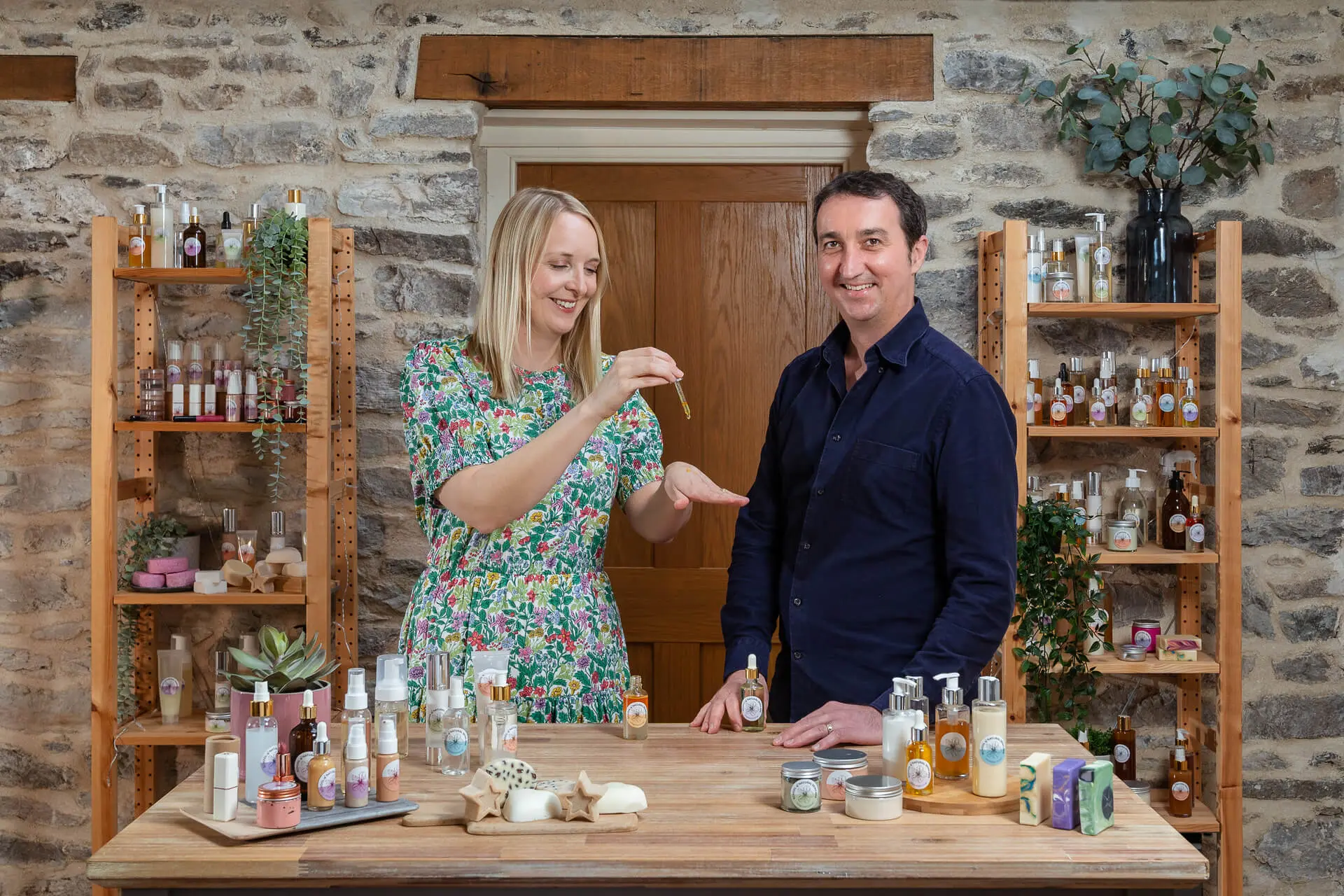
Take the shortcut to success
Save time and costly mistakes by following a proven framework that helps you succeed at formulating – the first time.
Become the independent creator of your own skincare masterpieces
Break free from following other people’s mistakes. Create exceptional quality, unique natural and organic skincare products with precision and innovation at a fraction of the price of the big brands.
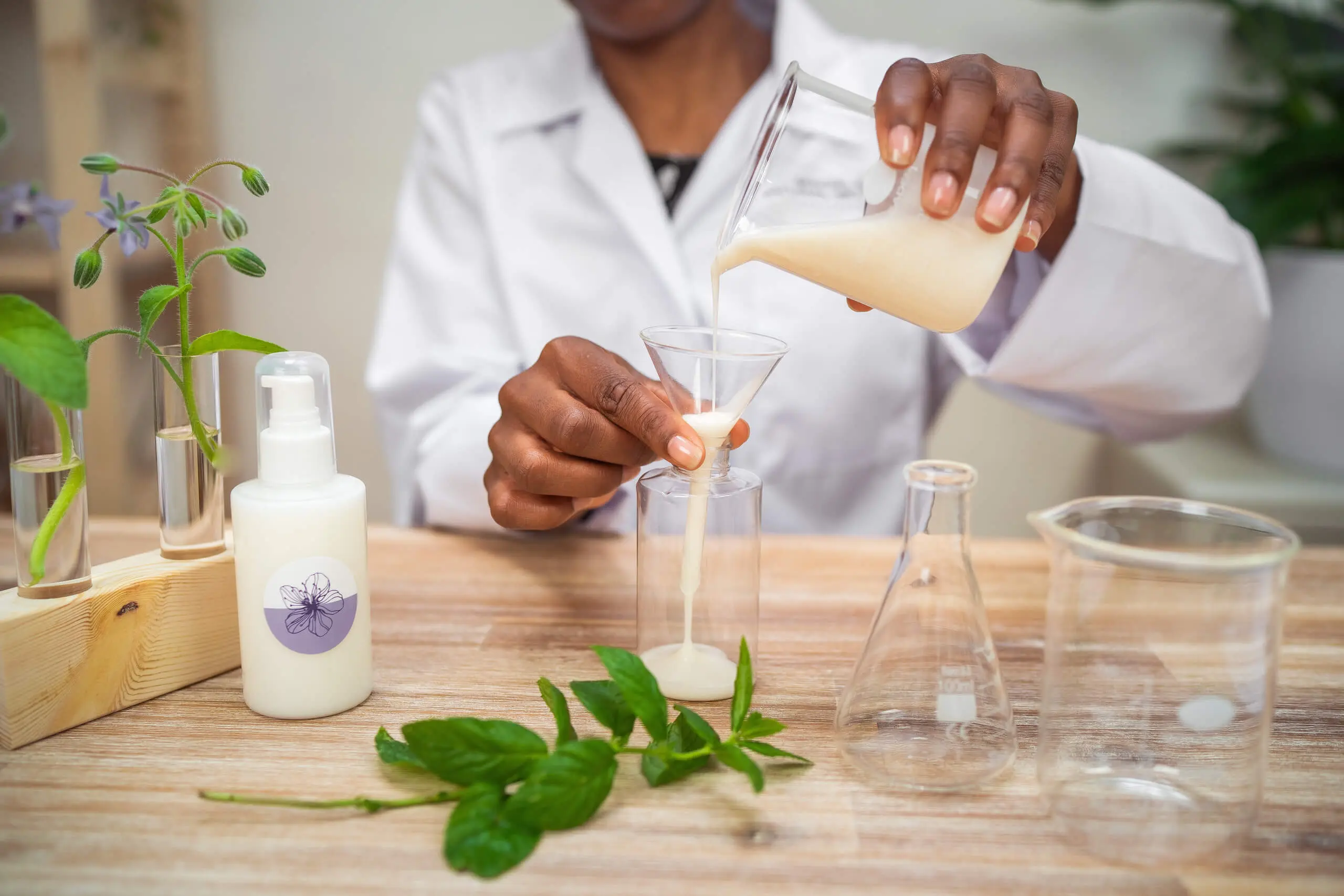
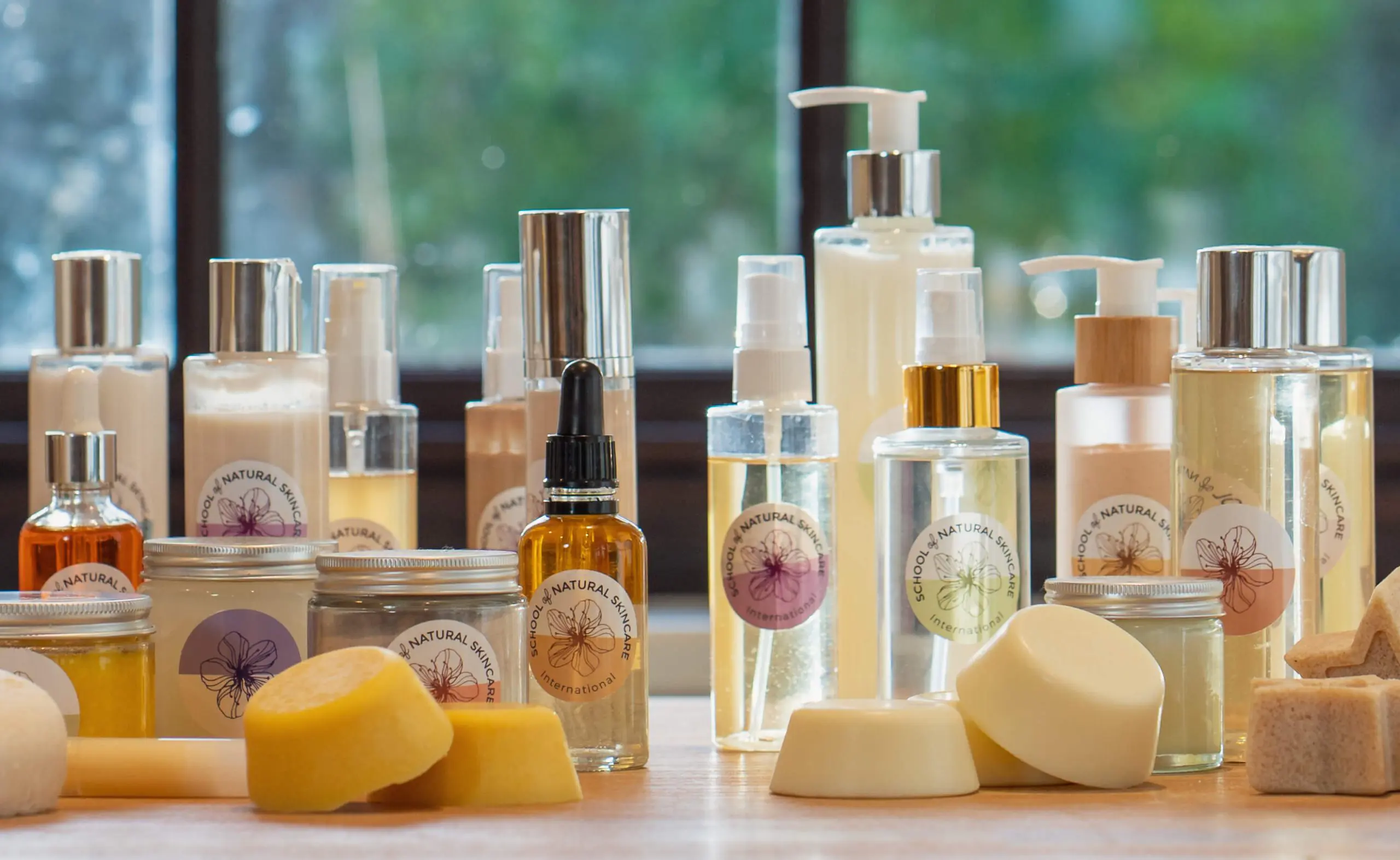
Build a business that takes you beyond formulating for fun
Do something meaningful with your passion for natural and organic beauty. Create products to sell and launch your own natural beauty brand.
Learn to formulate a complete skincare range:
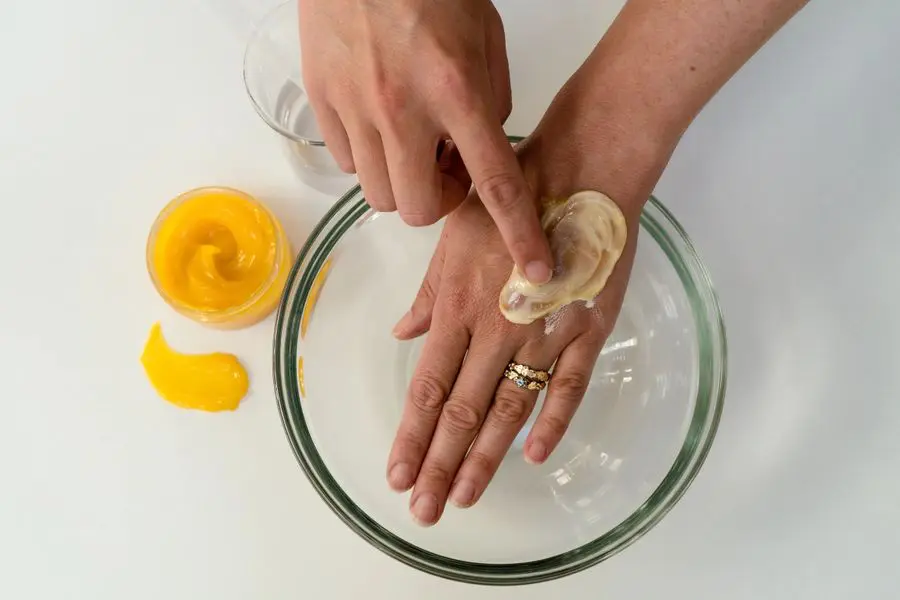
Cleansers
- Cleansing oils
- Oil-to-milk cleansers
- Cleansing gels/cleansing melts
- Cleansing balms
- Emulsifying cleansing balms
- Cleansing lotions
- Cream cleansers
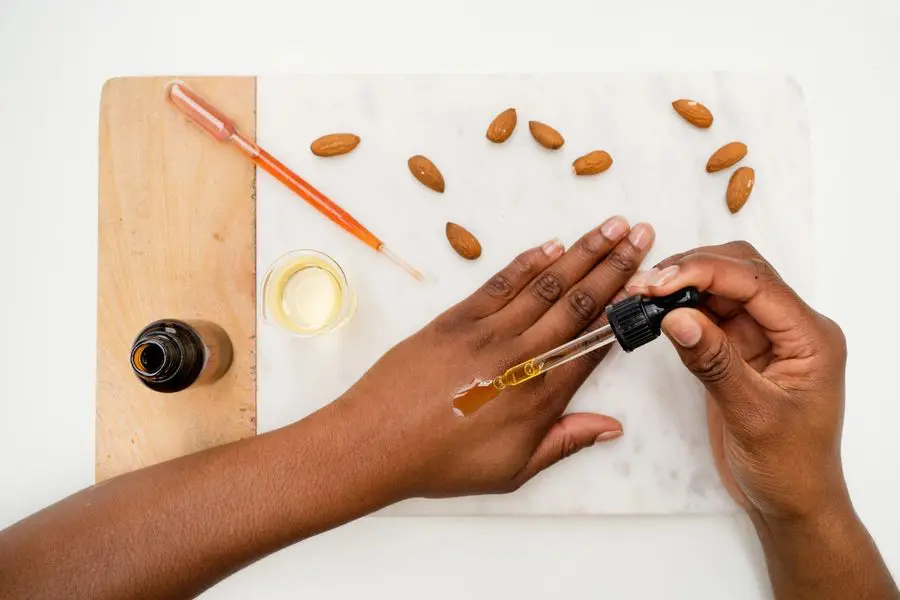
Oils and oil-based serums
- Facial oils
- Oil-based facial serums
- Body oils
- Massage oils
- Dry oil body spritz
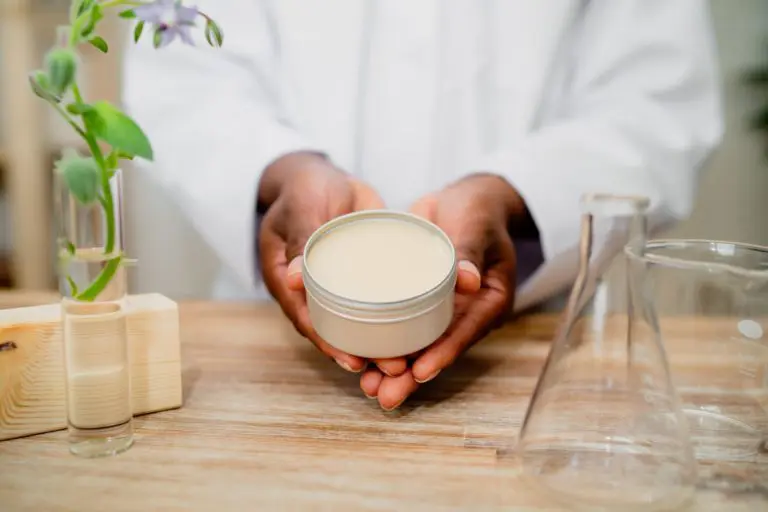
Balms and butters
- Lip balm
- Cleansing balm
- Facial balms
- Body balms
- Massage balms
- Salves
- Oil-gel balms
- Anhydrous whipped body butters
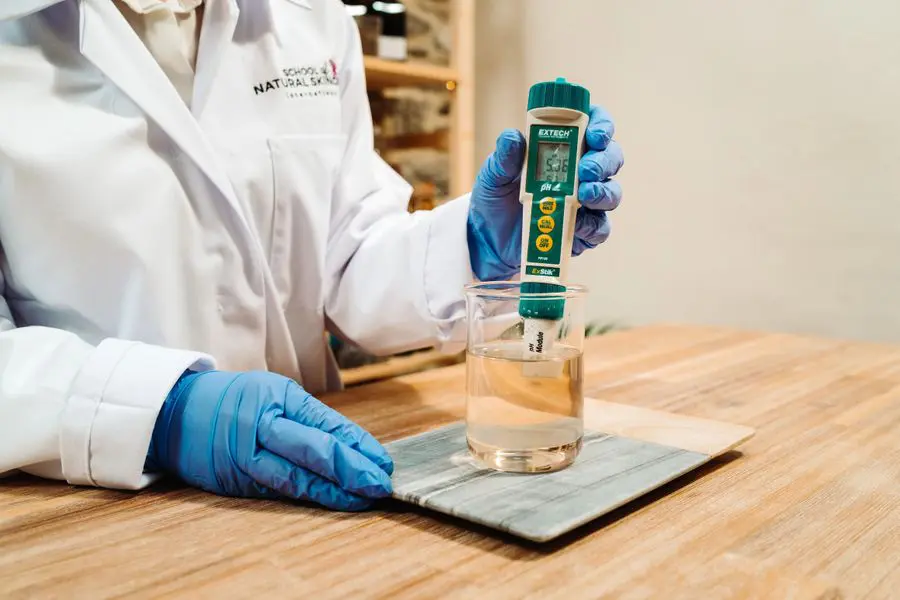
Toners
- Toners
- Spritzers/mists
- AHA/BHA toners
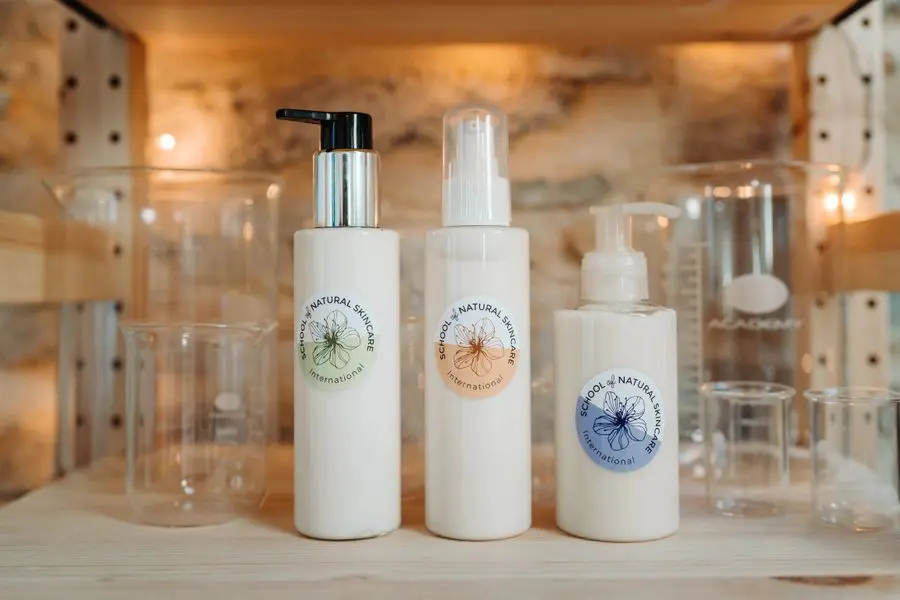
Creams and lotions
- Moisturizing fluid
- Oil-free moisturizing lotion
- Face lotion
- Face cream
- Body milk
- Body lotion
- Body cream
- Body butter
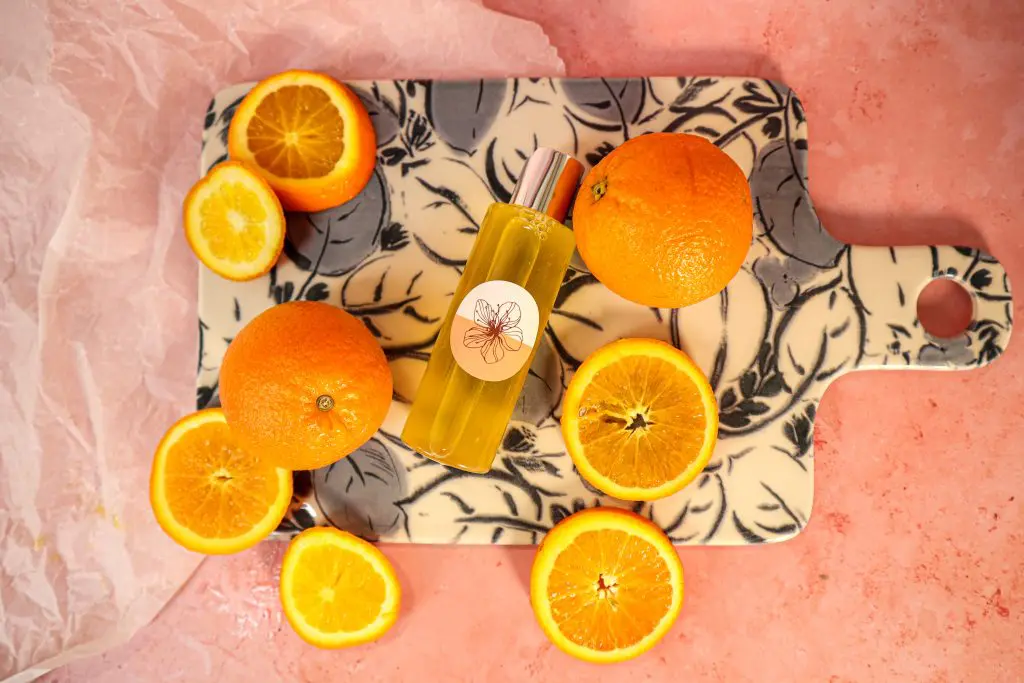
Bath and shower products
- Bath soaks
- Bath oil
- Self-emulsifying bath oil
- Shower oil
- Self-emulsifying shower oil
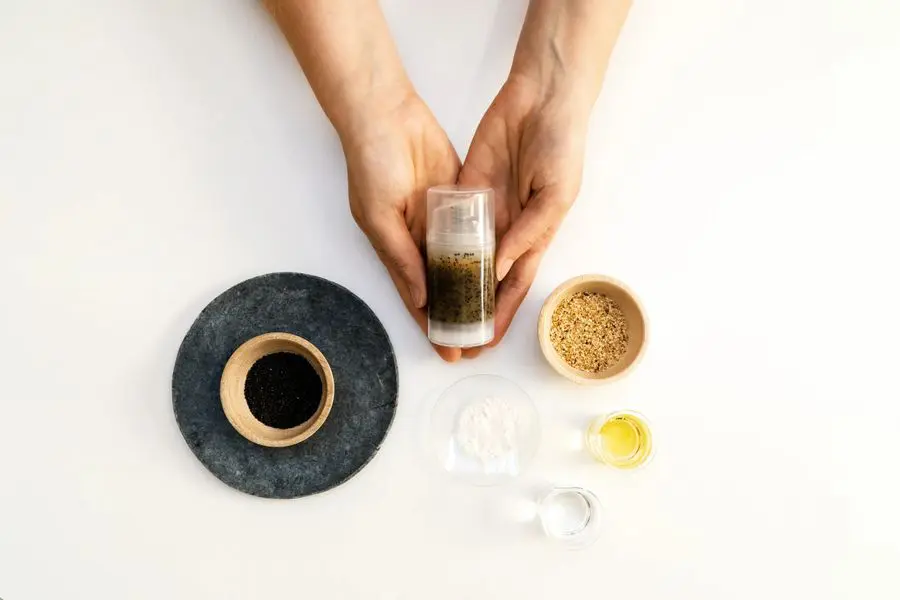
Exfoliators
- Exfoliating facial polish
- Exfoliating body polish
- Body scrubs
- Exfoliating lotion
- AHA/BHA exfoliating creams, masks and toner
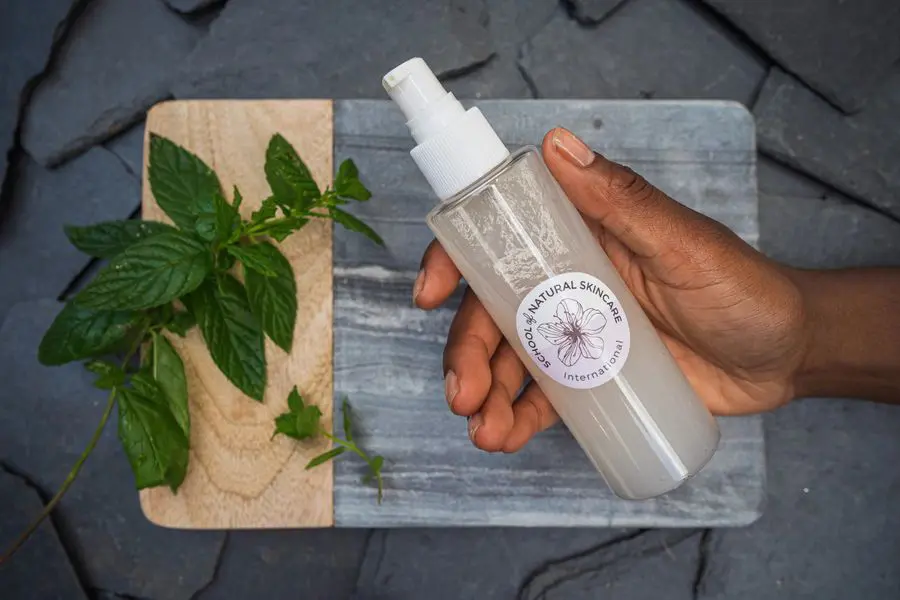
Gels
- Hydrating facial gels (water-based)
- Body gels (water-based)
- Oil-based gels (oleogels)
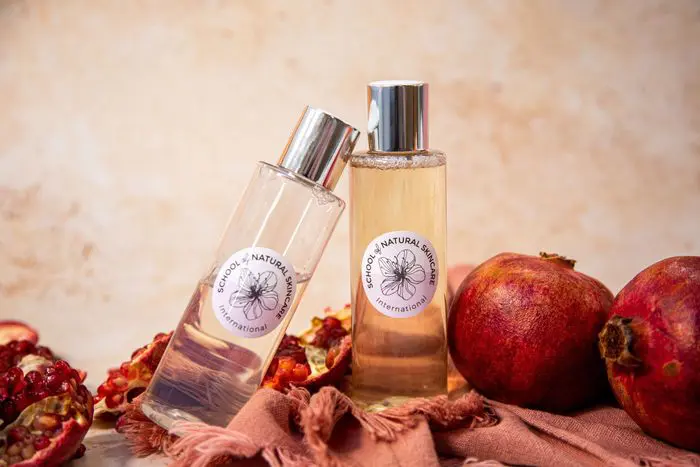
Surfactant products
- Facial washes/gel
- Body wash
- Shower gel
Your journey on the Diploma in Natural Skincare Formulation
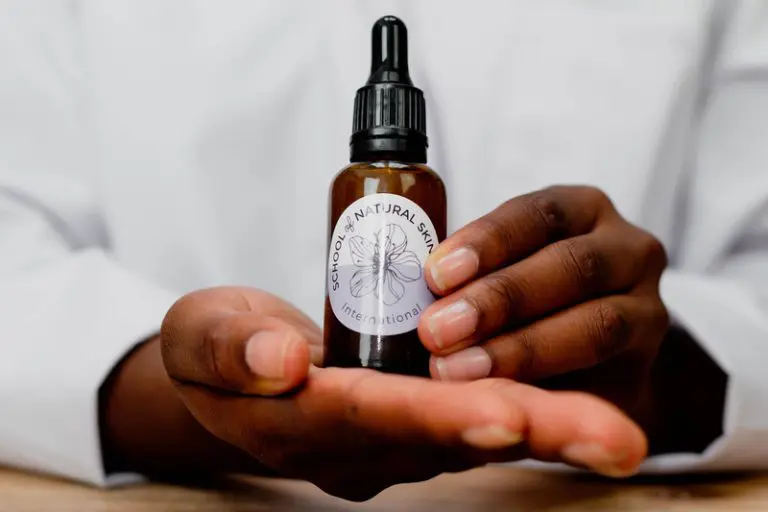
Brand values
Identify your brand values and create a unique brand
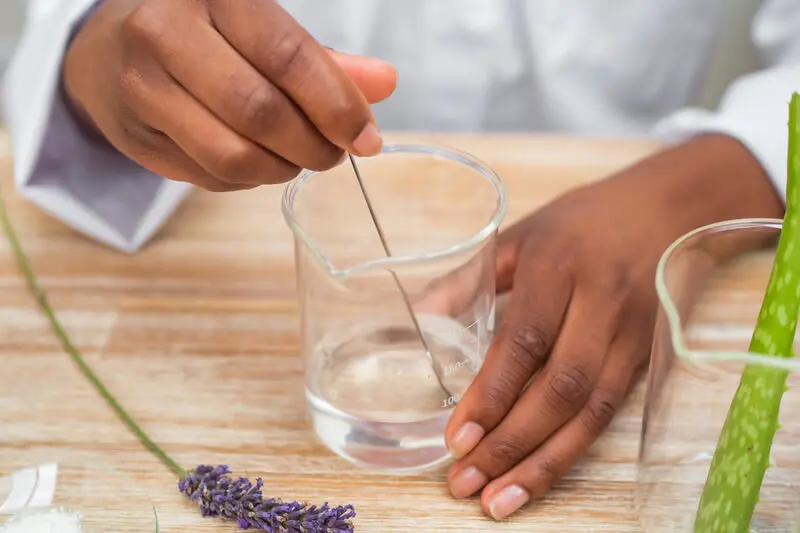
Formulation skills
Learn professional formulation skills
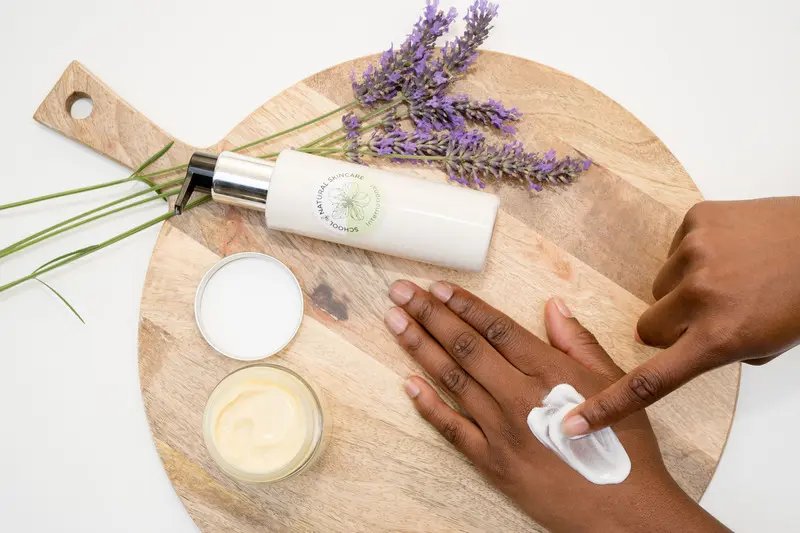
Skin anatomy
Formulate for different skin types, tones and concerns
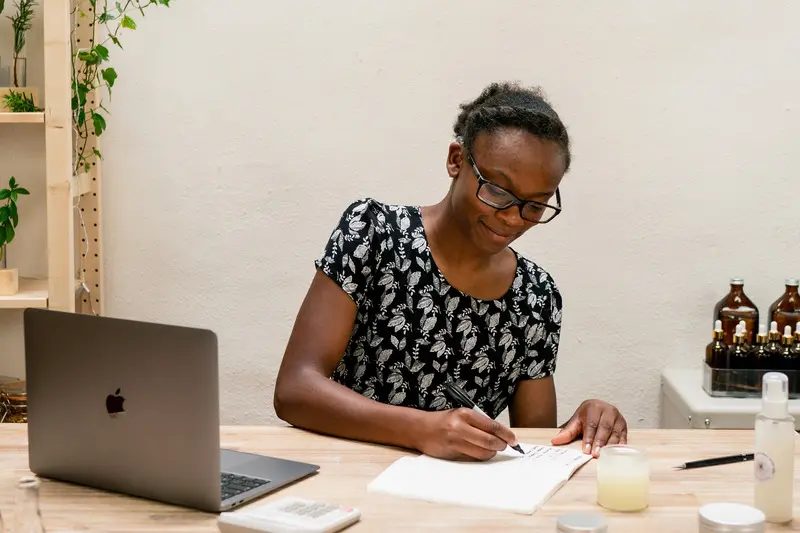
Natural ingredients
Increase your knowledge of natural ingredients
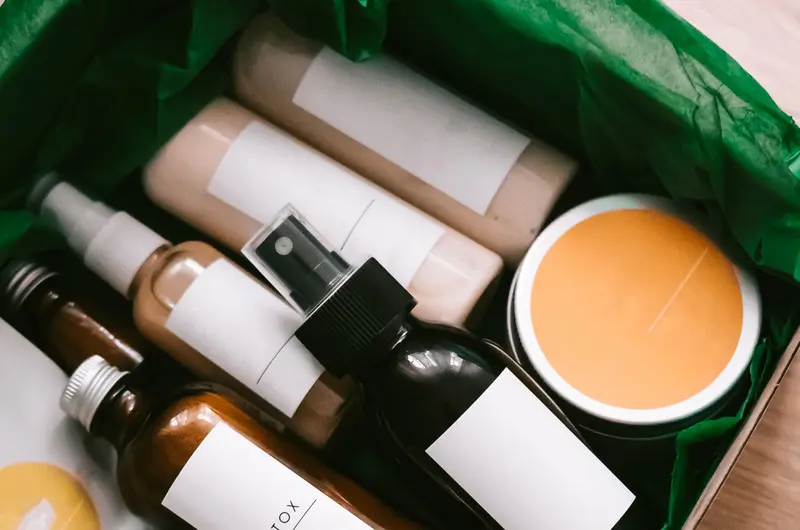
Business
Comply with cosmetic regulations and take your products to market!
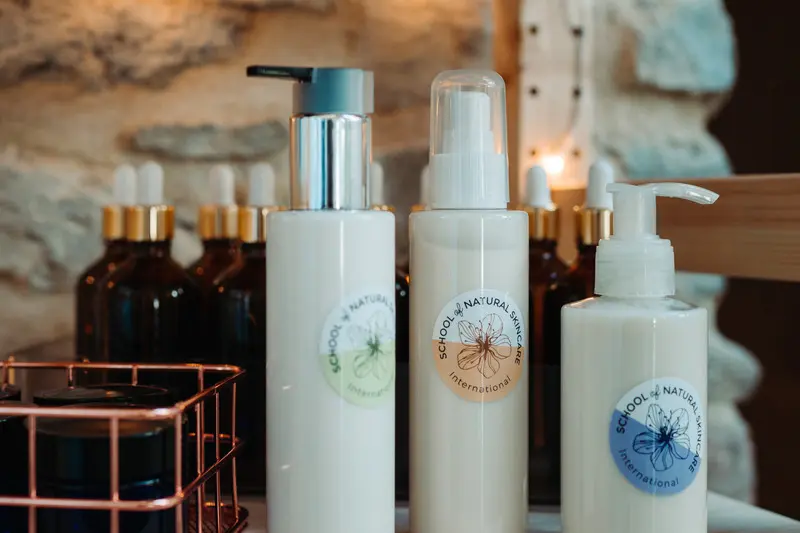
Products
Formulate a wide range of natural skincare products to a professional standard
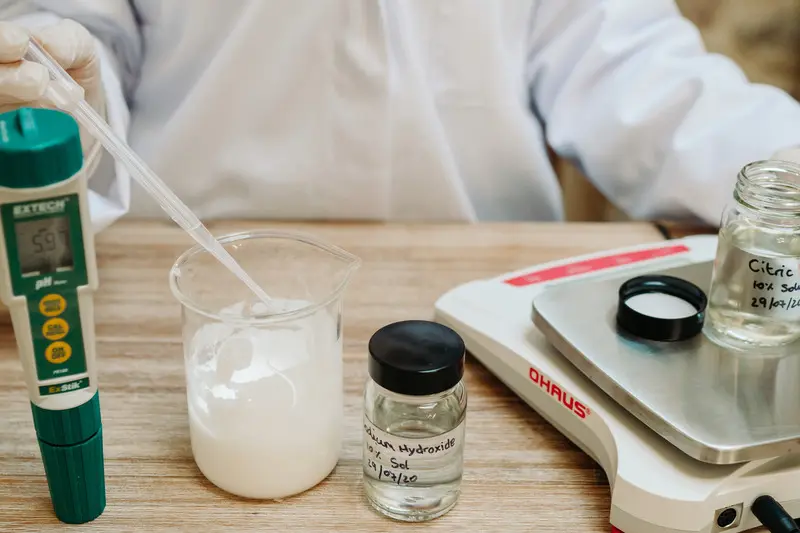
Preservation
Preserve skincare effectively and increase product shelf-life
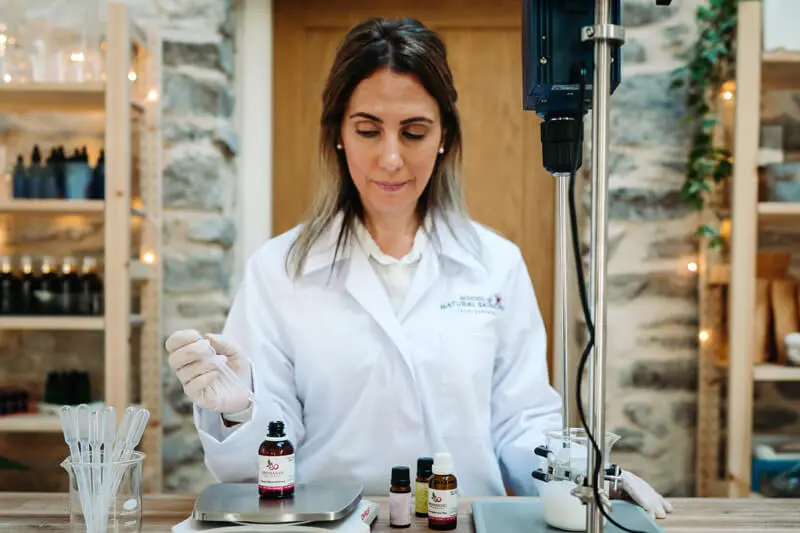
Lab skills
Set up your home lab, develop lab skills and carry out GMP

Brand values
Identify your brand values and create a unique brand

Formulation skills
Learn professional formulation skills

Skin anatomy
Formulate for different skin types, tones and concerns

Natural ingredients
Increase your knowledge of natural ingredients

Lab skills
Set up your home lab, develop lab skills and carry out GMP

Preservation
Preserve skincare effectively and increase product shelf-life

Products
Formulate a wide range of natural skincare products to a professional standard

Business
Comply with cosmetic regulations and take your products to market!
Meet your instructors and tutors
Learn from and be supported by cosmetic scientists and professional formulators.
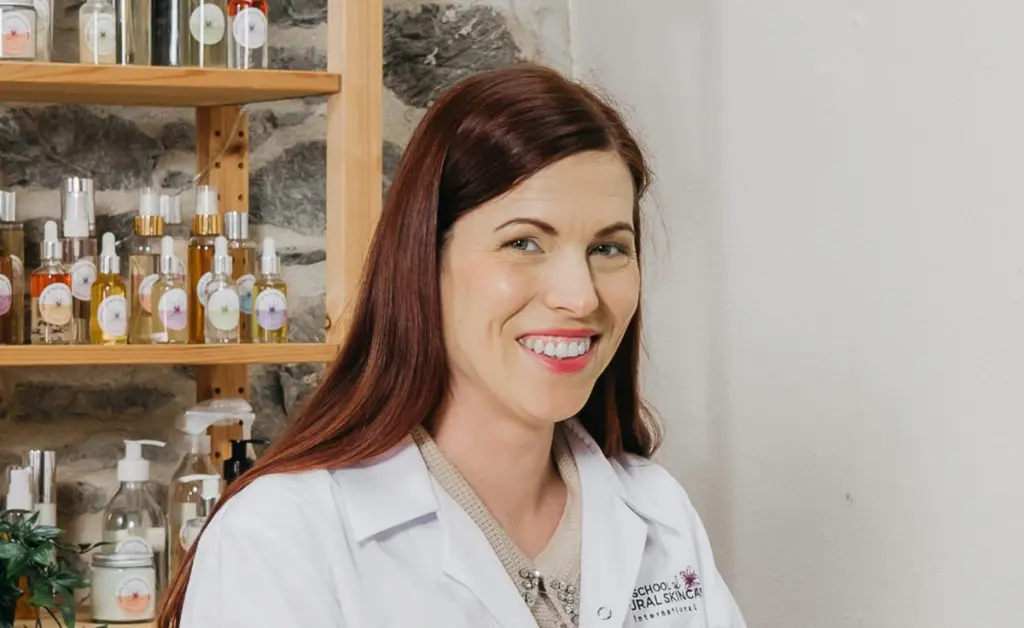
Tina Svetek
Tina is a cosmetic formulator, formulation consultant and safety assessor, who leads new product development for natural skincare and wellness brands.

Dr Nicole Voster
Nicole is a cosmetic formulation consultant and senior lecturer with extensive experience teaching chemistry and cosmetic formulation at South African universities and aiding brands in new product development.
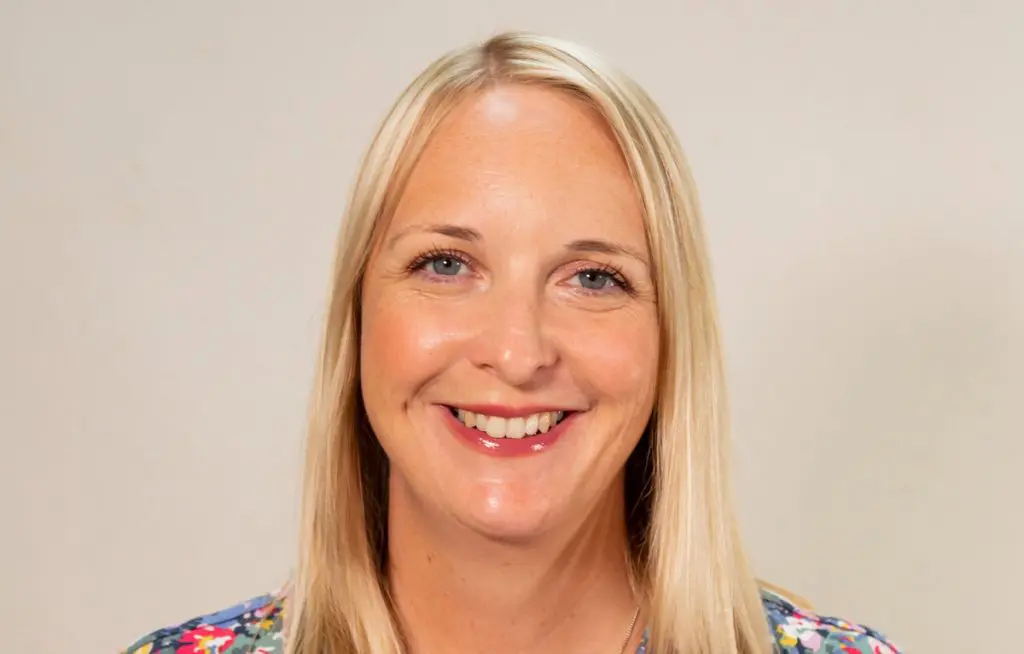
Gail Després
Gail is an award-winning entrepreneur and author of the A-Z of Natural Cosmetic Formulation. After creating her natural skincare brand, Gail moved into education, founding the School of Natural Skincare in 2010.

Gareth Després
Gareth qualified as a certified aromatherapist in 2010 and enriches the content of our online courses with his specialist knowledge of essential oils.
Is the Diploma in Natural Skincare Formulation right for me?
This course is perfect for…
Beginners
Beginners committed to their natural skincare journey
Learn everything you need to start formulating natural skincare products.
Read more
Develop and apply your new knowledge and skills immediately. No previous experience or scientific background is needed.
Intermediate
Skincare enthusiasts passionate about formulating
Take your formulation skills to the next level.
Read more
Make products for various skin types, tones and concerns. Explore your creative side by crafting your own formulations and making sustainable, natural, organic and/or vegan products to match your values.
Entrepreneur
Aspiring beauty brand owners
Take the leap and launch your own natural beauty brand.
Read more
Our Diploma is a complete, all-in-one course teaching you to create a brand and formulate high-quality professional cosmetics. You’ll also learn everything you need to know to take your brand to market.
Student testimonials

- Flora Ndukwe,
- Ireland
Now, I confidently formulate everything from moisturizers to serums.
The affordable and well-structured courses made learning straightforward and enjoyable. The tutors were exceptionally knowledgeable and made complex concepts easy to grasp. The comprehensive courses offered a solid foundation and the inspiration to start my own brand. I only wish I had found this school sooner.
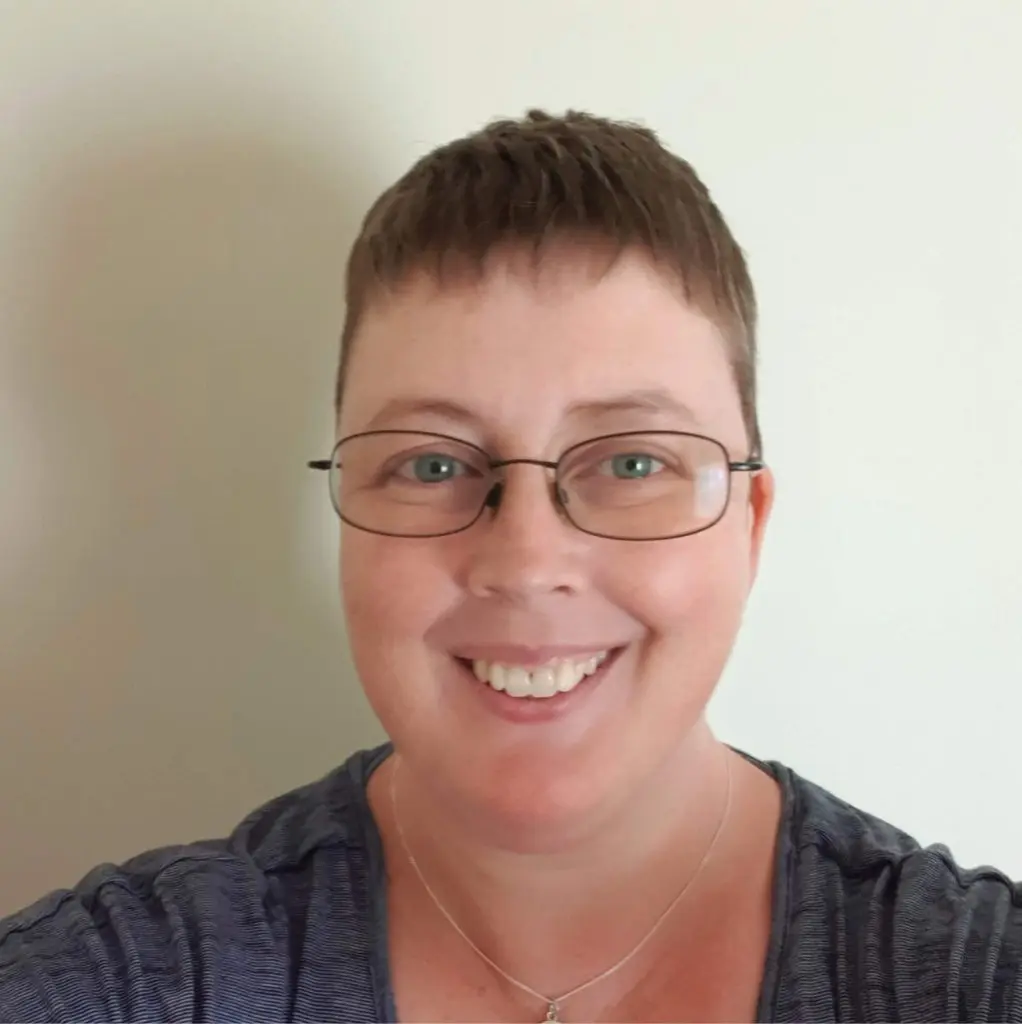
- Kylie Phillips,
- Australia
This course ignited my passion for skincare formulation and led to the launch of my own brand!
With sensitive skin in mind, I initially struggled with ingredient safety and effective formulations. I lacked confidence and didn’t know where to start. Now, I confidently create formulas, research ingredients, and understand what makes quality products. The self-paced online format, demo videos, and invaluable textbooks were crucial. I’m truly grateful!

- Mehmet Shevki,
- Cyprus
This course gave me everything I needed to make my own natural skincare.
After thorough research, I chose your course, and it’s been amazing! I now feel confident in creating creams and formulating my own products. The video demonstrations were especially helpful, providing clear, practical guidance. I’m truly grateful for the knowledge and inspiration it’s given me. Thank you!

- Heena Bhat,
- India
Before the course, creating stable emulsions was a challenge for me.
But after this course, I have created emulsions that are stable and result oriented. Understanding the ingredients and experimenting with them has become a lot easier now, too! Honestly, everything about this course is GREAT. Especially your sample formulations. They are amazing.
Why learn to formulate your own products?
Create your own unique, professional standard skincare products – don’t just copy recipes from others.
Select ingredients and design products tailored to the needs of yourself or your ideal customers – this is the key to creating products people love!
Save time and costly mistakes. Learn the skills to formulate like a professional, not an amateur.
It is YOUR responsibility to sell safe products. Don’t take any chances. Have peace of mind that you are creating high-quality, safe products.
Want to try before you buy?
Sample a selection of our course material inside our online classroom.
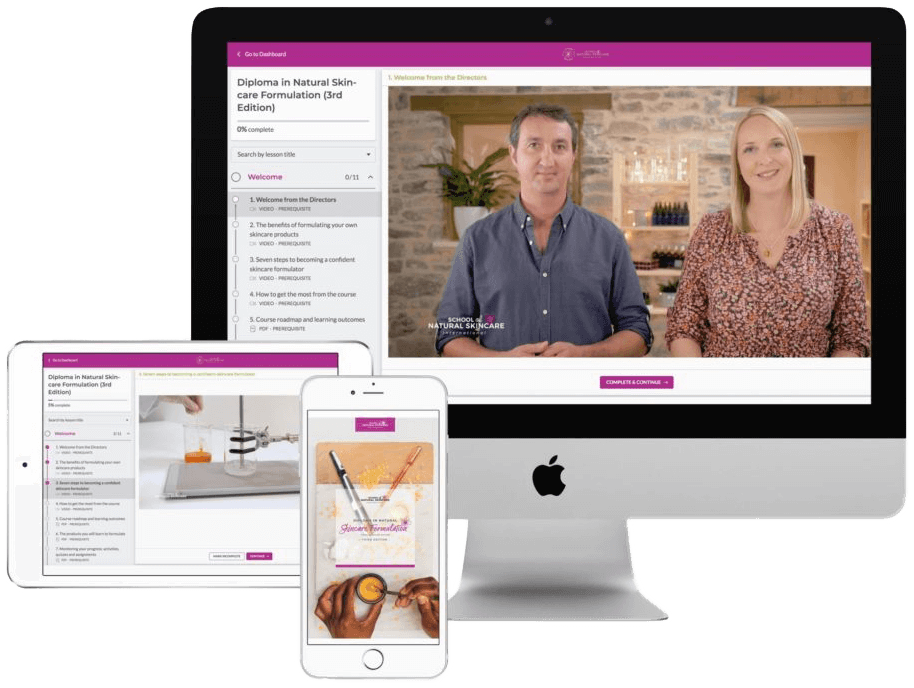
How does the Diploma in Natural Skincare Formulation work?
Our proven system for teaching formulation skills, developed over more than a decade of training provision, means when you study with us, you’ll gain the knowledge, skills, and support to succeed at formulating.

Knowledge
You don’t need a scientific background; our courses cover everything you need to know.
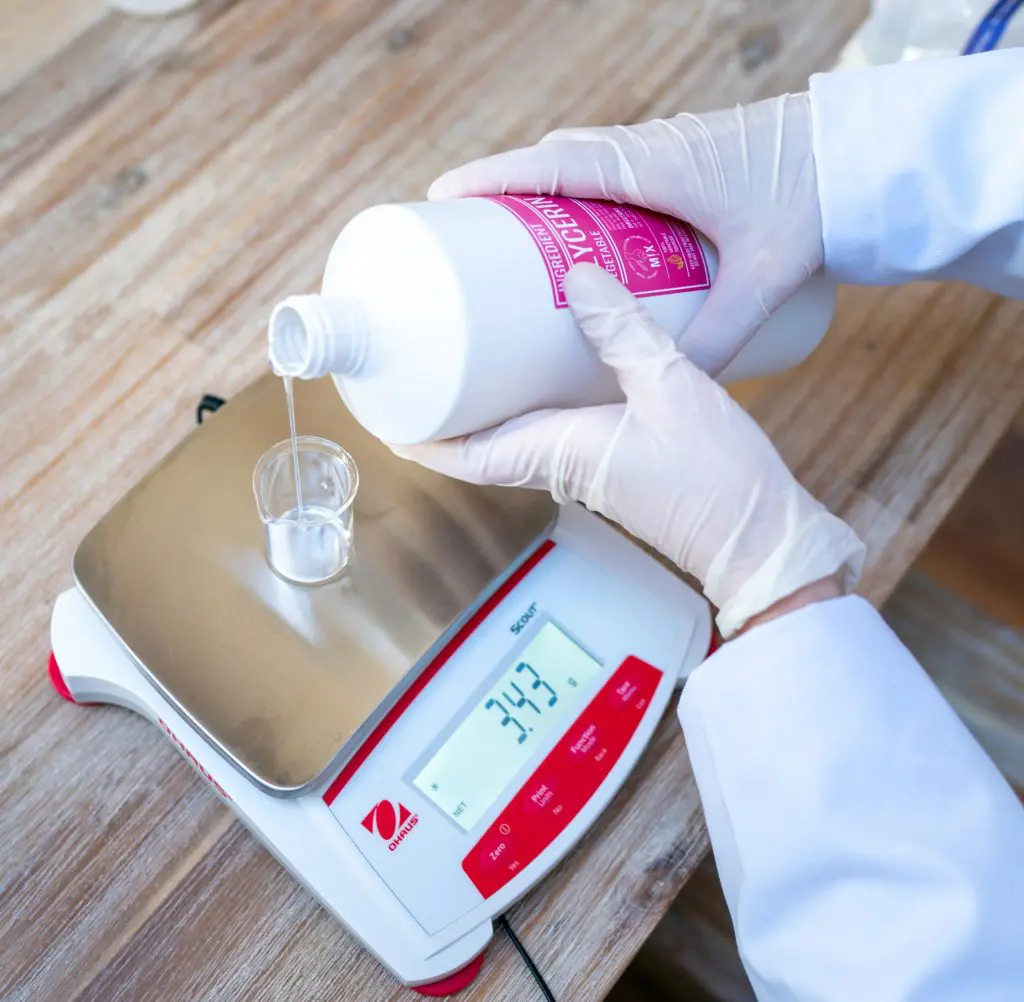
Skills
We start with more straightforward products and progress to the more complex or challenging ones so you can build your skills and confidence.
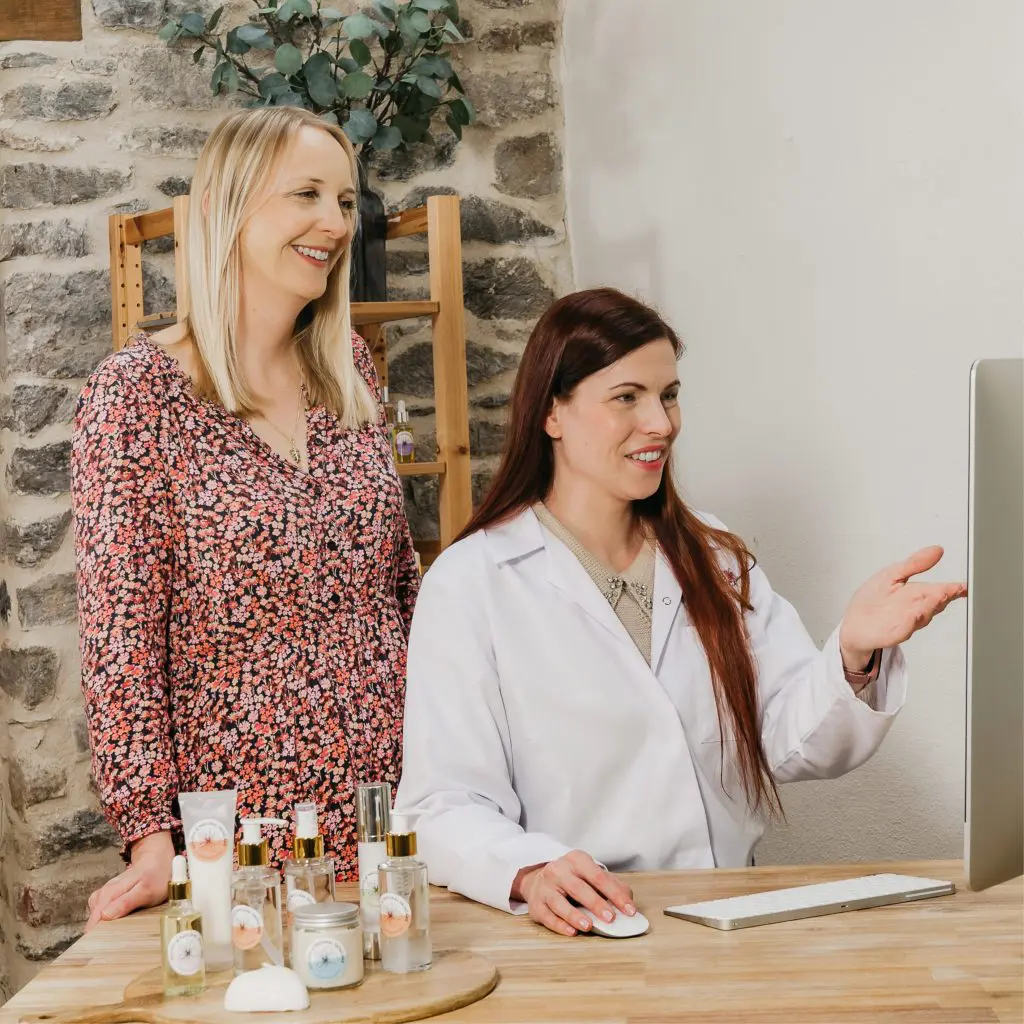
Support
You can rest assured that you are learning from qualified and experienced professionals and are not misled by inaccurate, poor-quality and unsafe information often found online.
We’ll teach you to formulate by providing the following resources for each type of product:
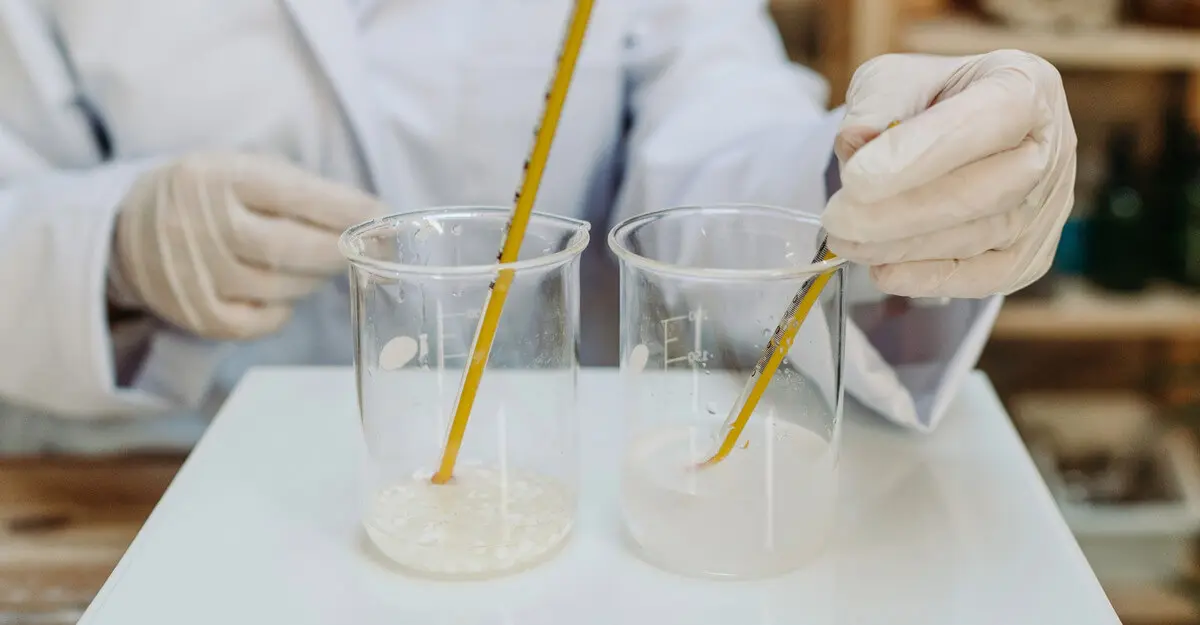
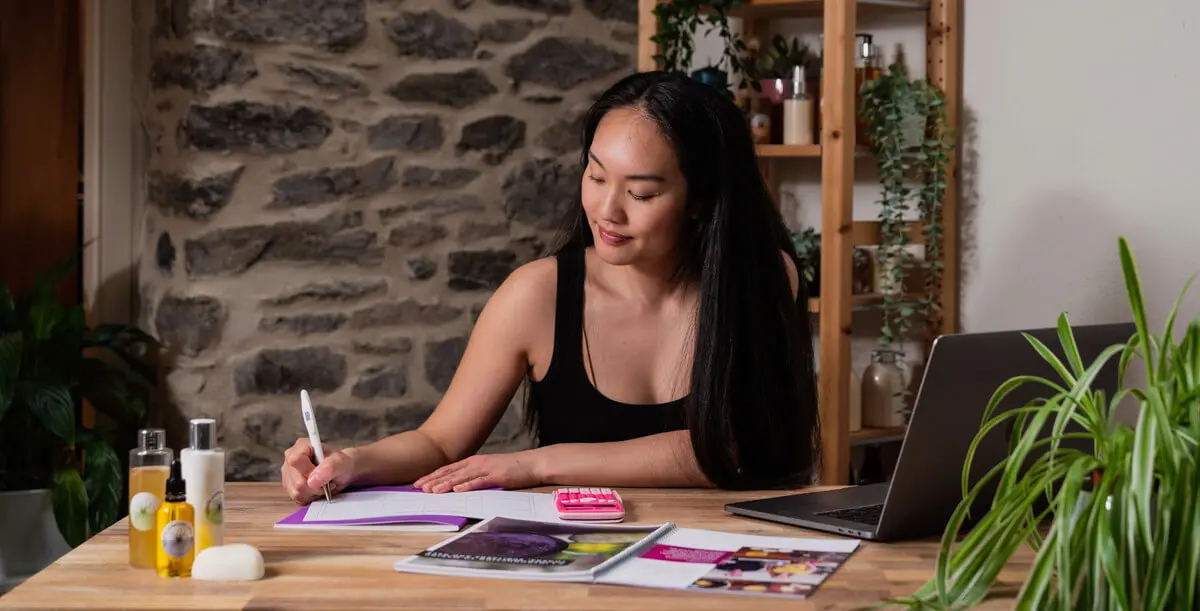
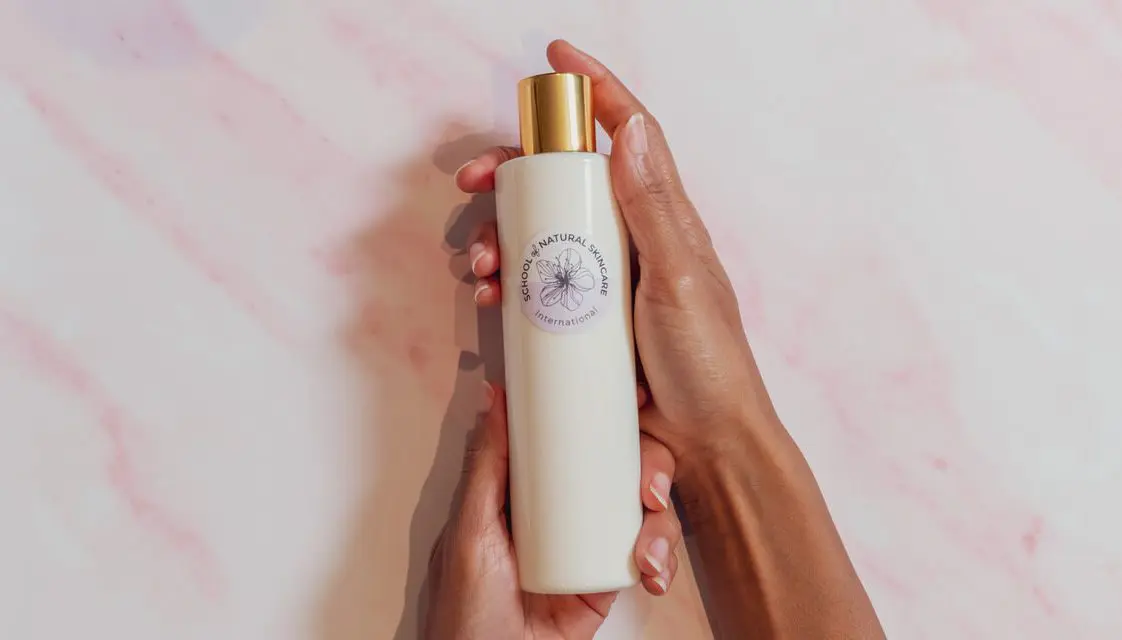
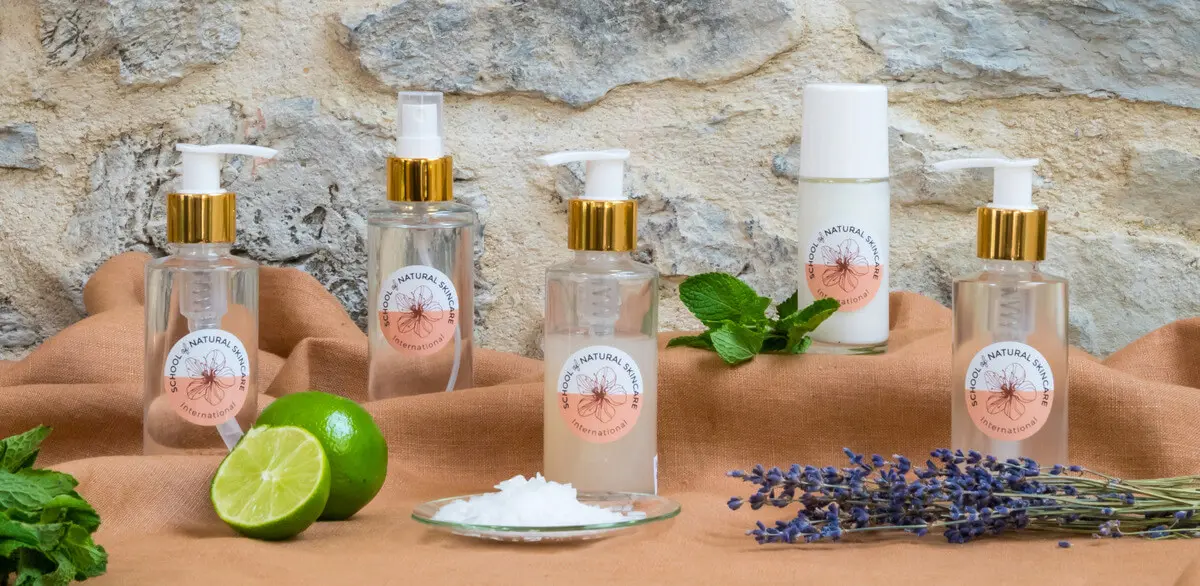
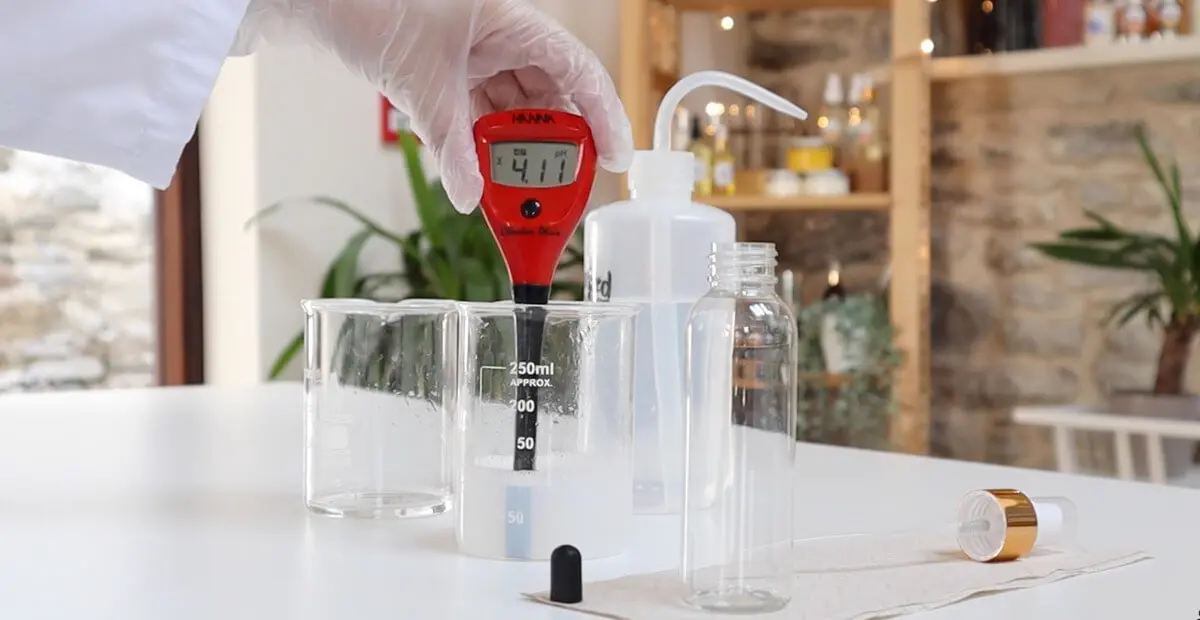
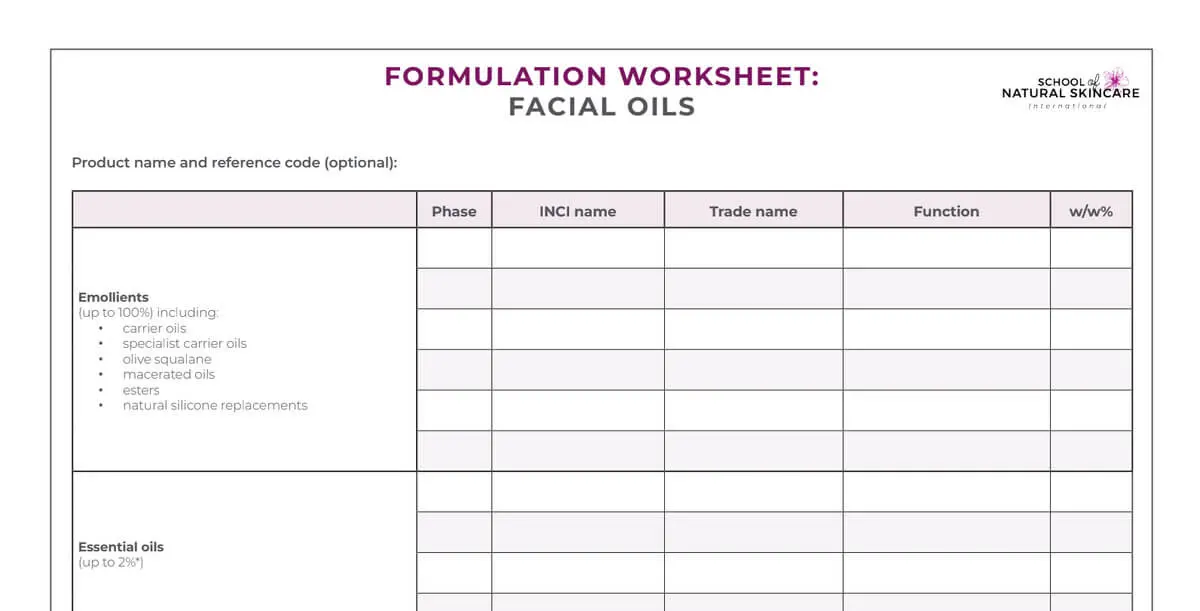
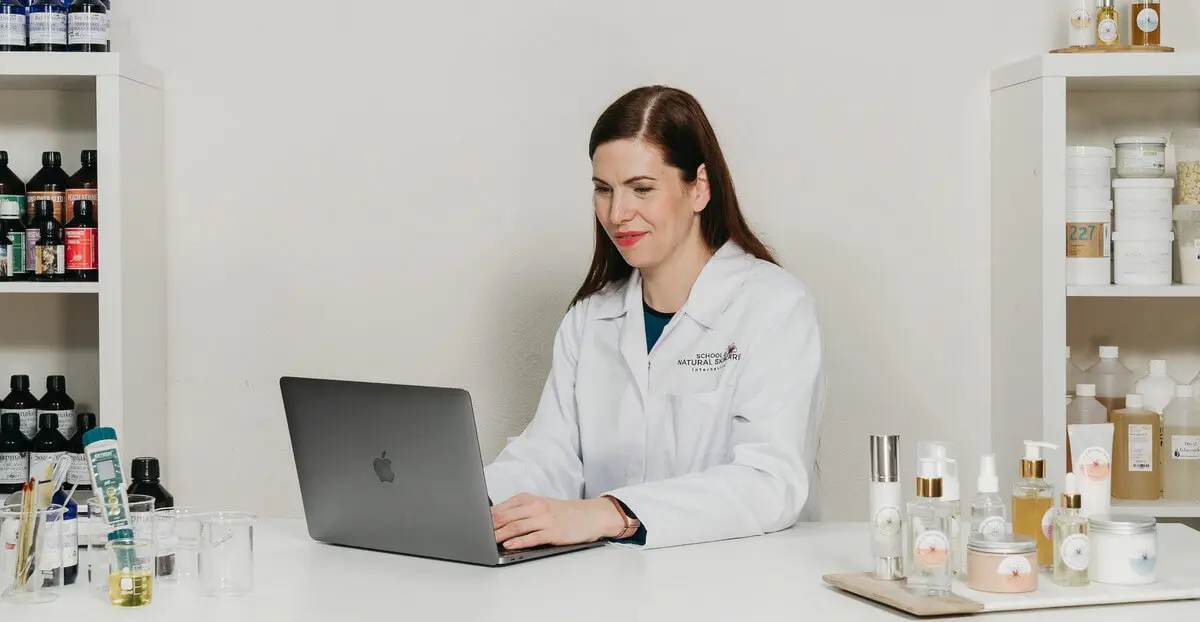
More than just a course, our Diploma in Natural Skincare Formulation includes the support and community you need to truly thrive in your formulating journey
You’ll receive:
14 in-depth modules accompanied by detailed downloadable textbooks with step-by-step instructions and beautiful photographs.
Full HD video classes including step-by-step product making demonstrations.
70+ formulation examples to practice with and 25+ preservative efficacy test reports.
Join our supportive, vibrant community of like-minded students and graduates across the world.
Easy-to-use online classroom, quizzes, and activities.
14 workbooks and 28+ downloadable, fillable worksheets.
Assignments marked personally and a course completion certificate.
An in-depth library of ingredient information, plus resources for further research.
Be supported by cosmetic scientists
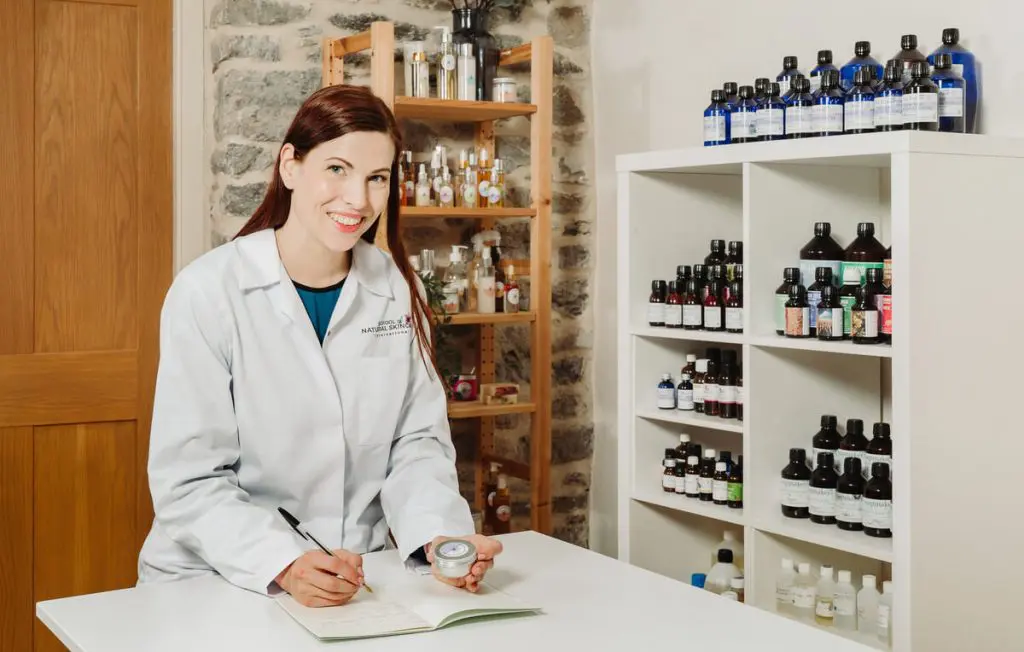
Get your questions answered
each week in our dedicated Tutor Q&A
Join the professionals
for LIVE course sessions
Expand your understanding
with our monthly Formulators Forum, a LIVE learning and discussion session on Zoom
Have your end-of-course assignments personally marked
by our cosmetic scientists
Plus
Receive an invitation to join our private student and graduate online community.
Connect with like-minded formulators around the world inside our friendly student community. It’s the perfect place to discuss, support and inspire each other.
Student testimonials
The course has greatly enhanced my skills and confidence.
- Cara Wetherall,
- Australia
After a year of self-taught skincare formulation, I struggled with misinformation and felt stuck with basic products. I sought more advanced knowledge, which led me to your course. Now, I have a solid understanding of ingredient properties and how to use them effectively. I particularly enjoyed learning about extracts and calculating batch sizes.
- Cara Wetherall,
- Australia
The course has set me up for success!
- Penelope Da Luca,
- USA
I can create AMAZING emulsions and serums and I am overjoyed to watch them come together successfully. I put all of my passion into my formulations. I loved the demonstrations of how to make different products. I want to tell you how grateful I am that I found this school! It’s exactly what I needed to launch my dream! Thank you so much!
- Penelope Da Luca,
- USA
I was completely lost with online information.
- Pujitha Raja,
- UK
Enrolling with the School has been worth every penny! I had no idea about formulating skincare products. I was completely lost with online information, didn’t know what to trust or where to start. The videos were great and I am now confident that my ingredient knowledge has improved significantly. I can formulate effective and natural skincare products.
- Pujitha Raja,
- UK
I can now formulate, myself, without copying it off the internet!
- Norma Segovia,
- USA
I didn’t know anything about preservatives or emulsifiers and many other ingredients. I was following other recipes on the internet, incorrectly believing an internet recipe is safe and accurate, but I never used a formula. I didn’t even understand the difference between them. Now, I am confident in myself and feel proud. I feel that I have learned tremendously from the School of Natural Skincare.
- Norma Segovia,
- USA
I’m so grateful for this school—it’s exactly what I needed to launch my dream!
- Myadagmaa Tsedendamba,
- Mongolia
I’ve always dreamed of launching a natural skincare brand, because commercial products irritated my sensitive skin. These courses helped me learn how to create effective emulsions and serums at a professional level. The video demonstrations and textbooks were incredibly useful, and I’m proud of my progress.
- Myadagmaa Tsedendamba,
- Mongolia
Look inside the online classroom
All our training is completed through our easy-to-use online classroom.
Study from anywhere in the world at your own pace.
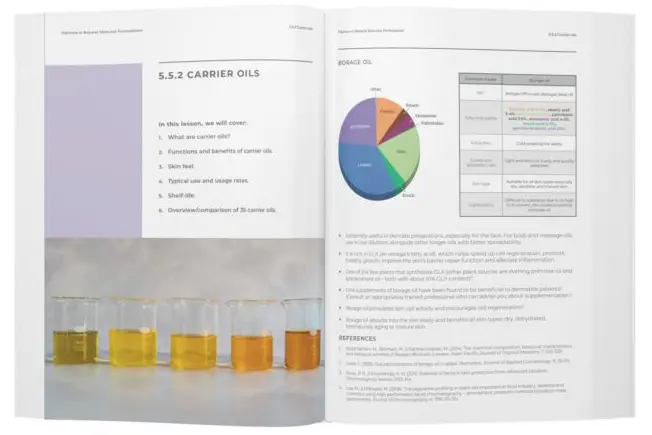
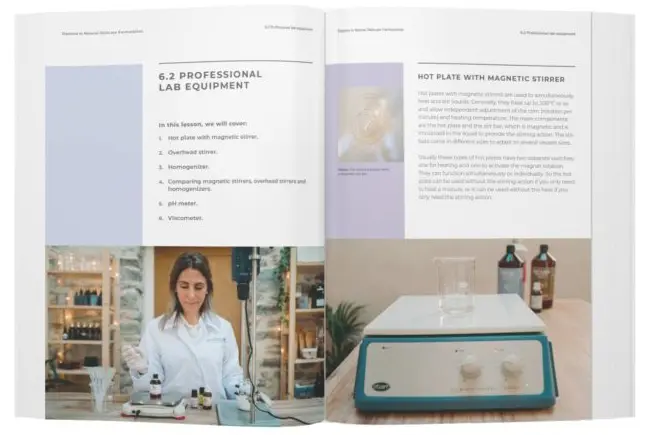
Why study with the
School of Natural Skincare?
Be part of our accredited, globally acclaimed, award-winning online formulation school that’s seen over 25,000 students from 150 countries enjoy mastering the art, science, and creativity of making natural and organic skincare.
Learn from and be supported by professional cosmetic scientists.
Tried and tested formulations. Our formulas have passed Preservative Efficacy Testing.
Formulate your way – natural, organic, vegan, sustainable – and customized to your skin type, tone and concerns.
Multi-award winning and accredited school, established in 2010.
Study with us for our own enjoyment and learning or to create a beauty brand.
Study at a pace that fits your lifestyle.
99% of our students would recommend the course to others.
Realize your dreams of formulating natural skincare like a pro.
Featured in






Where are our graduates now?
For many of our students, their ultimate goal when studying with us is to start their own beauty brand.
Here are some of our graduates who have gone on to become beauty entrepreneurs across the world. If this is what you aspire to, we can’t wait to see your story here one day soon.
How Graduate Stephanie Went From Years of Dabbling In Her Kitchen To Launching Her Brand Coco-Bare
The Inspiring Journey of a Natural Skincare Entrepreneur, Esther Julius
Memhet Shevki’s Rewarding Journey in Crafting Natural Cosmetics: It’s A Family Affair!
A Mother’s Personal Quest for Truly Natural Skincare
Organic skincare products: How formulating organic skincare products is a revolutionary act for Good Flower Farm
How Tanya juggled life with kids, work and studying natural skincare to launch her beauty brand, Indagare Beauty
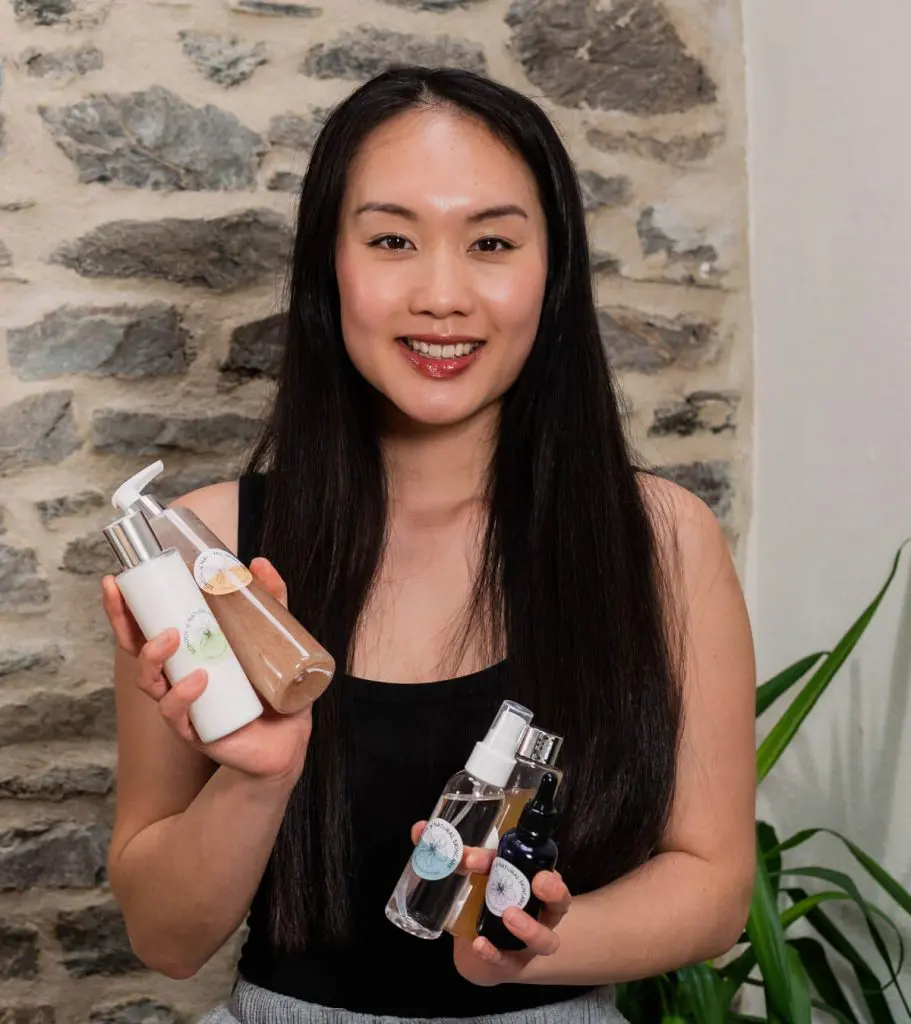
What you need to know:
Level
Beginner to intermediate.
Schedule
Self-paced course with on demand lessons. Study at a time that suits you. Optional live sessions.
Study time
Approximately 70-150 hours. Complete the course as quickly or slowly as you wish. Most students complete the course within 6-18 months.
Course access
18 months. This can be extended for a small fee.
Prerequisites
None. You’ll need the internet and a computer or tablet to access our online classroom.
When can I start?
Enrollment is open a few times a year. Find out when the next intake begins.
What you’ll study:
Module 1: Your Values, Brand and Creating Unique Products
Create a unique brand by establishing your personal or brand values, considering which niche to fill or certifications to adhere to, creating a product story and defining your brand’s unique selling proposition.
Read more
- Define your values so you can create a unique brand that stands out from the crowd.
- Explore vegan, sustainable, waterless, natural, organic and clean skincare and which is right for you.
- Discover 10 key aspects of a strong brand identity to a create a brand that your ideal customers love.
- Create a captivating product story showcasing your products’ unique selling proposition (USP).
- Map out your skincare line and hero product.
Module 2: Skincare Product Design Process
Follow our step-by-step design process to formulate products and select ingredients to achieve your or your customers’ desired results. Learn the steps required to take a product from concept to a final product ready for sale.
Read more
- Avoid one of the biggest mistakes founders make by getting to know who you want to sell your products to first and then create something that meets their needs.
- Learn the secrets to designing a product customers need, want, love and will buy repeatedly.
- Discover the seven key aspects of a great performing formula.
- Learn the step-by-step process of taking a idea from product concept to final formula.
BONUS: Formulate a Facial Oil Challenge. Start your formulating journey by following our six-part formulation challenge!
Module 3: Creating Professional Cosmetic Formulations
Develop a product concept using a product development brief and a benchmark, correctly write a formula, evaluate your product’s sensory characteristics and submit your product for the appropriate lab tests.
Read more
- Ensure your products fit the definition of a cosmetic rather than a drug (the line is easy to cross!).
- Learn the three main types of cosmetic formulas. You will never be confused about whether you need a preservative again!
- Discover how to write a professional formula, the essential information to include and why.
- Use our signature product development brief as your secret weapon to designing skincare products that work.
- Discover how to ‘reverse formulate’ or use a product on the market to create a similar product.
- Evaluate the sensorial properties of your products to perfect your formula. Our product evaluation template makes this easy!
- Learn about types of cosmetic product testing to ensure your products are safe for consumers and that you are meeting your legal requirements.
View all modules
Module 4: Skin Anatomy and Physiology; Formulating for Different Skin Types
Apply knowledge of how the skin functions, the physiological changes that occur as the skin ages, and common characteristics of different skin types, tones and concerns. This will enable you to formulate products suited for oily, sensitive, dry, combination and aging skin or concerns such as hyperpigmentation.
Read more
- Learn the seven main functions of the skin and about the structure of the skin in detail.
- Discover the significance of the skin barrier and how to keep it in optimum condition to prevent dryness, flakiness and sensitivity.
- Learn how to effectively moisturize the skin, and the benefits and limitations of anhydrous products and emulsions.
- Understand in detail how the skin ages, the physiological changes, visible signs of skin aging and how skincare products can improve the appearance of aging skin.
- Formulate for different skin types and concerns.
- Learn about the role of cosmetics for skin conditions, including acne, eczema/dermatitis, hyperpigmentation, psoriasis and rosacea.
Module 5: Cosmetic Ingredients and Raw Materials
Learn to confidently select ingredients and cosmetic raw materials appropriate for your formula by applying your knowledge of various ingredients’ functions, properties and benefits.
Read more
- This module is a vast library (nearly 500 pages!) of reliable, accurate information you’ll refer to again and again.
- Understand the chemistry of lipids and learn about a wide selection of carrier oils, esters, butters and waxes.
- Discover a wide range of natural humectants, clays, powders, exfoliants, active ingredients, antioxidants, vitamins, botanical extracts and natural colorants.
- Use, choose and blend essential oils with confidence referring to both our quick reference charts and detailed profiles to help you.
- Calculate essential oil allergen levels and know when to include allergens on your product label.
- Create stable cosmetics by understanding natural emulsifiers, self-emulsifying emulsifiers, thickeners, solubilizers and pH adjusters.
- Organize and store ingredients properly in your home lab and follow our six-step process for finding substitute ingredients.
Module 6: Lab Skills, Equipment and Packaging
Set up a home lab with the appropriate equipment, adhere to good manufacturing practices, carry out key production process techniques and make batches of different sizes.
Read more
- Recommendations for simple pieces of equipment you need to set up your own small-scale lab at home.
- Discover professional laboratory equipment useful for scaling up production.
- Use our easy-to-follow guidelines and templates for Good Manufacturing Practices (GMP).
- Develop the key lab techniques and skills you need: weighing, heating, calibrating, sanitizing, mixing, homogenizing, filling and calibrating.
- Follow our detailed demonstrations on how to use a pH meter to measure and adjust pH – an essential skill for all formulators to develop.
- Finally understand formulation math and how to calculate different batch sizes. We even provide a handy batch calculator to make it really easy!
- Discover types of cosmetic packaging and closures and the nine factors to consider when choosing packaging.
Module 7: Preserving Skincare Products Naturally
Put strategies in place to extend your products’ shelf-life and preserve them effectively to stay in optimum condition.
Read more
- Protect your products and your customers from harmful microbial growth.
- Follow eight strategies for extending the shelf-life of your cosmetics (using preservatives is only one) to ensure the highest quality and longest shelf-life of your products.
- Discover our nine favorite COSMOS-approved broad-spectrum natural preservative blends that are reliable and easy to use.
- Discover how to optimize the effectiveness of a preservative and problem ingredients that should be avoided.
- Sometimes a broad-spectrum preservative blend is not enough. Learn how to combine preservatives and use chelating agents to create a robust, broad-spectrum preservative system.
Module 8: Formulating Oils, Oil-based Serums and Self-emulsifying Oils
Formulate and make a range of anhydrous oils, oil-based serums, and self-emulsifying oils for the face, bath and body.
Read more
Formulate dry oil body spritzes, body oils and massage oils, facial oils and oil-based serums, oil-to-milk bath and shower oils, cleansing oils, oil-to-milk cleansing oils and cleansing gels.
This module includes:
- Formulation guides and templates to follow to make formulating easy.
- How to choose ingredients, product shelf-life and how to evaluate your formula.
- Detailed step-by-step video demonstrations to follow.
- A helpful troubleshooting guide.
- Example formulations for Moringa Dry Oil Body Spritz, Coconut and Lime Body Oil, Soothing Facial Serum for Sensitive Skin, Antioxidant Facial Serum with Coenzyme Q10, Lime and Sweet Orange Shower Oil, Lavender and Bergamot Bath Oil, Grapefruit Cleansing Oil, Pomegranate Cleansing Gel and Frankincense Intense Cleansing Melt.
Module 9: Formulating Butters and Balms
Formulate and make a range of gorgeous anhydrous, preservative-free balms and butters, including whipped body butters, lip balms, facial and body balms and salves, oleogels and cleansing balms.
Read more
This module includes:
- Formulation guides and templates to follow to make formulating easy.
- Inspiration and guidance for taking balm-style formulations to the next level.
- How to choose ingredients, product shelf-life and how to evaluate your formula.
- Experiment and report: Do anhydrous cleansing balms need preservatives?
- Detailed step-by-step video demonstrations to follow.
- A helpful troubleshooting guide to address issues such as How do you make less oily feeling butters? How do you increase their melting point? How do you stop them from going grainy?
- Example formulations for Whipped Body Butter with Babassu Oil and Illipe Butter, Sweet Orange and Kokum Whipped Body Butter, Vegan Calendula Salve, Wild Rose Beauty Balm, Illipe and Murumuru Lip Balm, Sweet Almond Moisturizing Gel-balm and Coconut, Illipe and Green Tea Cleansing Balm.
Module 10: Formulating Spa-style Soaks, Scrubs and Polishes
Formulate and make a range of indulgent soaks, scrubs and polishes just like you’d find in a high-end spa.
Read more
This module includes:
- Formulation guides and templates to follow to make formulating easy.
- How to choose ingredients, product shelf-life and how to evaluate your formula.
- Experiment and report: testing preservatives in an anhydrous sucragel-based body scrub
- Detailed step-by-step video demonstrations to follow.
- A helpful troubleshooting guide.
- Example formulations including Relaxing Rose and Milk Bath Soak, Invigorating Peppermint Foot Soak, Peach and Poppy Seed Body Scrub, Vanilla and Shea Sugar Scrub and Mango, Coconut and Sugar Lip Scrub.
Module 11: Formulating Toners, Spritzers, Mists and Gels
Formulate and make a range of refreshing toners, spritzers, and mists using delicate hydrosols and botanicals. Create hydrating gels for the face and body with powerful humectants.
Read more
This module includes:
- Formulation guides and templates to follow to make formulating easy.
- How to choose ingredient including water soluble extracts, vitamins and humectants, product shelf-life and how to evaluate your formula.
- Experiment and report: Three natural solubilizers
- Experiment and report: How hydrosols can challenge the performance of the preservation system
- Detailed step-by-step video demonstrations to follow.
- A helpful troubleshooting guide.
- Example formulations including Juniper Berry and Lemon Toner, Green Tea Toner for Oily Skin, Hydrating Hyaluronic Acid Toner, Brightening Gel with Licorice and Niacinamide for Hyperpigmentation and Deep Moisture Oil-free Gel.
- Preservative efficacy test reports.
Module 12: The Science of Emulsification
Learn the essential science behind creating stable emulsions so you can successfully formulate creams and lotions and solve stability issues.
Read more
In this module, you will learn:
- The structure of an emulsion formula and the essential ingredients to include.
- What an emulsifier is and how they work.
- How to choose the best emulsifier for your formula.
- The science of emulsification.
- The phases and stages of making an emulsion.
- How to modify the rheology and viscosity of your creams and lotions.
The four causes of emulsion instability and how to solve them.
Module 13: Formulating Creams and Lotions
Formulate and make a range of creams and lotions for the face and body, from light, oil-free lotions and sprayable body milks to nourishing lotions, richer creams, and body butters.
Read more
This module includes:
- Formulation guides and templates to follow to make formulating easy.
- How to choose ingredients, product shelf-life and how to evaluate your formula.
- Experiment and report: Testing four natural emulsifiers.
- Detailed step-by-step video demonstrations to follow.
- A helpful troubleshooting guide.
- Example formulations including Sweet Summer Body Milk, Geranium and Macadamia Body Lotion, Coconut and Shea Body Butter, Frankincense Face Cream for Mature Skin with Coenzyme Q10, Facial Lotion with Licorice and Niacinamide for Hyperpigmentation, Eye Cream with Caffeine and Ceramide Complex, Soothing Cleansing Lotion and Olive Exfoliating Lotion.
- Preservative efficacy test reports.
Module 14: Cosmetic Regulations and Business Essentials
Meeting regulatory standards is essential for bringing products to market. Learn how to comply with cosmetic, labelling and claims regulations to launch your brand with confidence.
Read more
This module includes:
- Seven important steps to take before you sell your products.
- Guidelines and templates for all the most important documents you need to keep including a Product Information File (PIF).
- Detailed guides to the cosmetics regulations in the USA, Canada, EU, UK, Australia, New Zealand, South Africa and India.
- Advice about cosmetic claims – what you can and cannot claim about your products and how to substantiate any claims you make.
Limited Time Bonus Classes
Enroll before midnight (Los Angeles Time) on Monday 31st March and you’ll receive these three exclusive bonus classes for FREE!
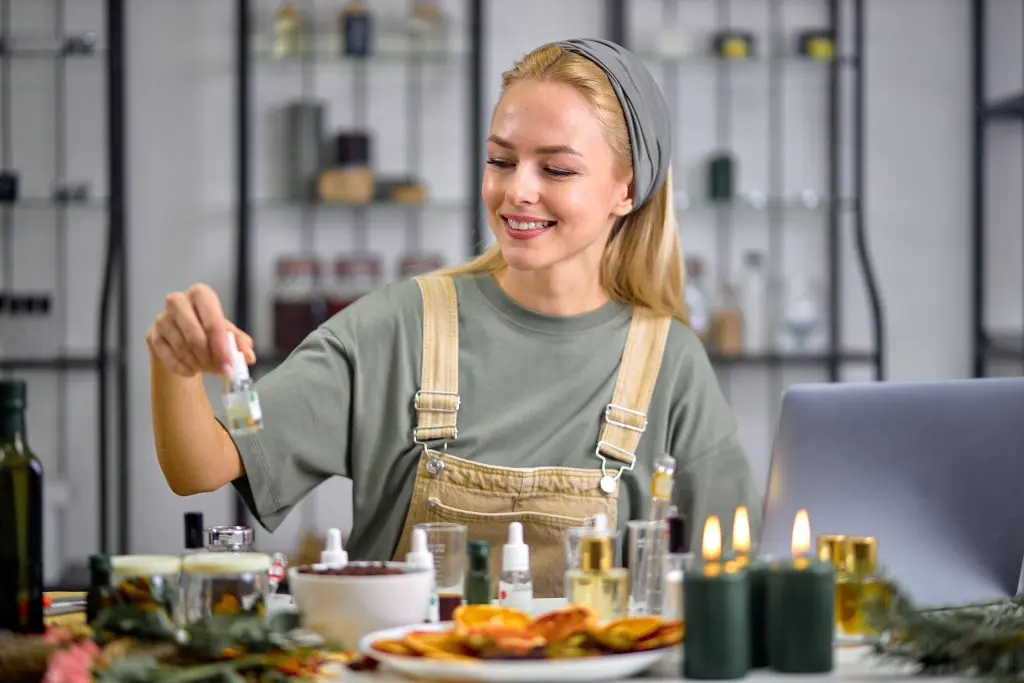
Craft Your Natural Skincare Brand in 5 Days
Complete our five-day challenge to kickstart your natural skincare brand. Craft your vision and lay the foundations for creating your brand. It’s easy, fun, and your first step towards building the beauty brand of your dreams.
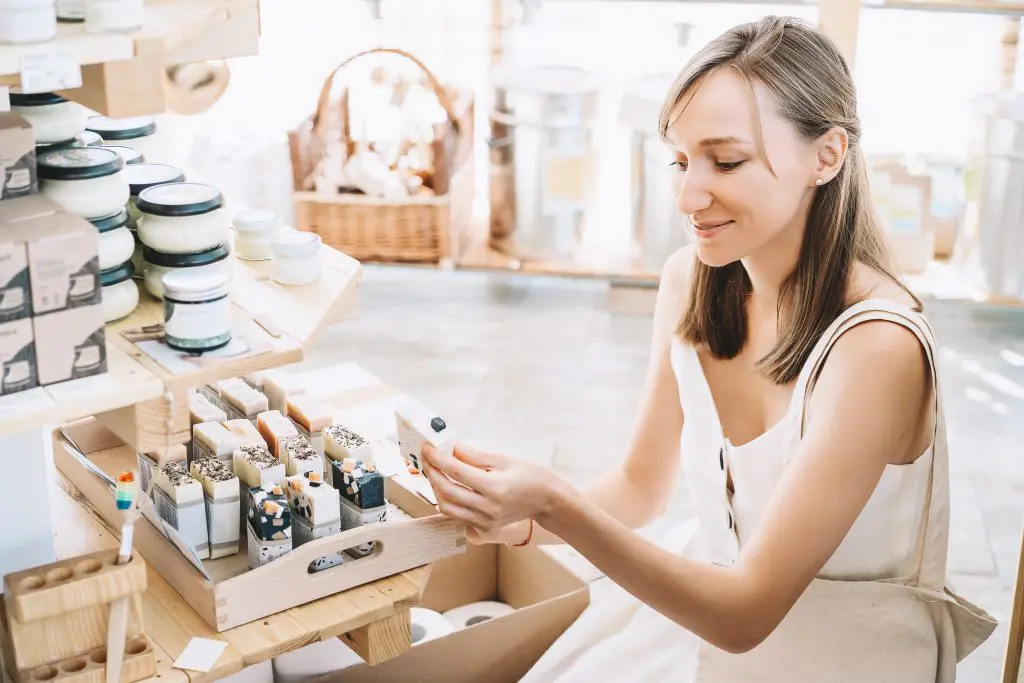
How to Price Your Cosmetic Products for Profit
Learn how to correctly calculate your costs, prices and margins so you profit from every product. Discover the art and science of pricing, from strategy to psychology, and how to use pricing to position your natural beauty brand in the marketplace.
Guide to Attending Cosmetic Conferences and Trade Shows
Attending beauty industry trade shows can increase brand visibility and help you find new customers, buyers, distributors and retailers. Learn how to get the most out of these events and the best shows worldwide.
Bonus Masterclasses
You will also receive access to three Masterclasses with your enrollment.
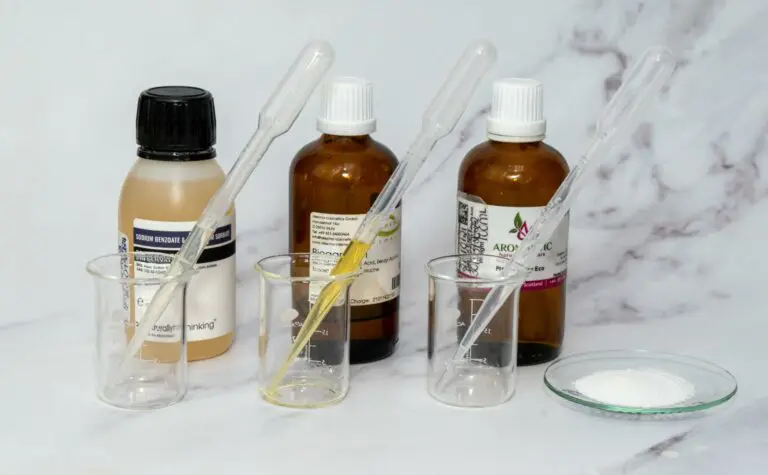
Masterclass 1: Unlock the secrets to preserving your skincare formulations naturally
Struggling with skincare preservation? Learn how to protect your products from bacteria, mold & yeast! Discover which formulas need preservatives, the best natural options, key preservation steps, and common mistakes—plus get an easy-to-use preservatives chart!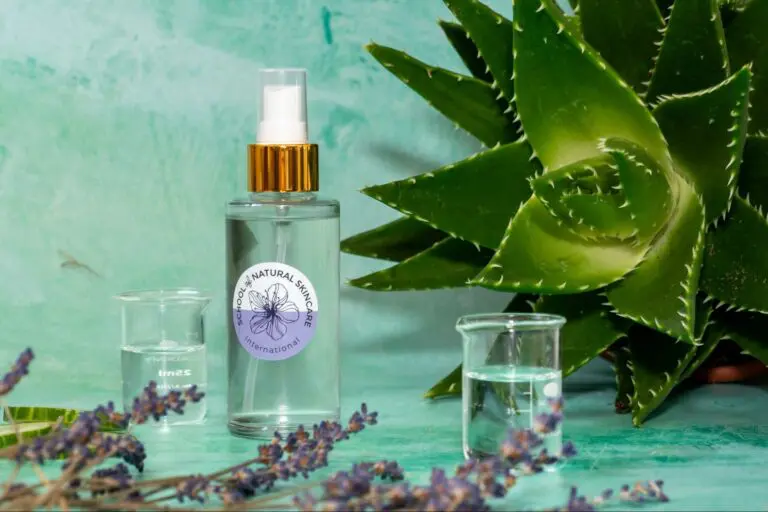
Masterclass 2: How to formulate hydrating toners, mists and gel-serums – the professional way
Ready to go beyond oil-based skincare? Discover how to create hydrating toners, mists, essences & gels using powerful ingredients like hyaluronic acid, aloe & sodium lactate. Learn pro formulation techniques, avoid common mistakes & get two tested formulas!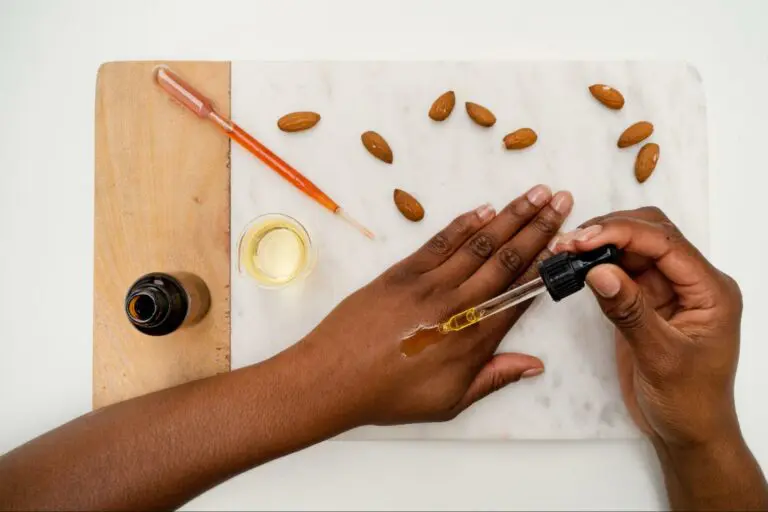
Masterclass 3: Formulate natural skincare with potent actives and botanical extracts
Discover powerful active ingredients & botanical extracts for anti-aging, hydration, skin barrier support & more. Learn how to use antioxidants, vitamins & CO2 extracts effectively—plus get a Vegan Calendula Salve formula to nourish and soothe the skin!Bonus materials
You’ll also receive three additional resources as a bonus to further your skincare formulation skills.
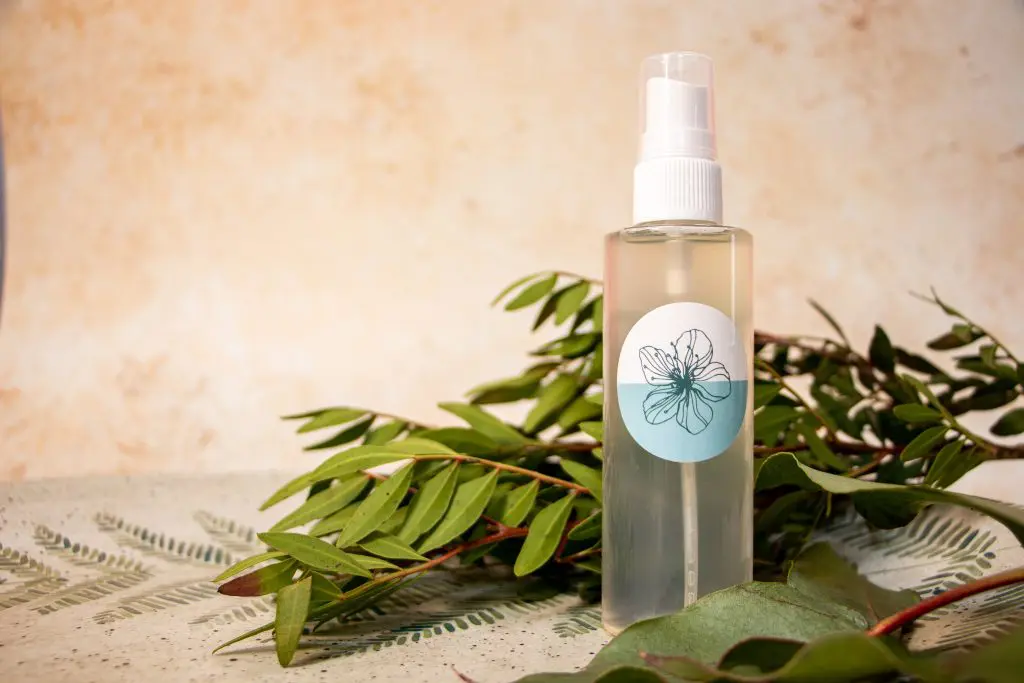
Formulating with
AHAs and BHAs
Our detailed guide covers the benefits of using AHAs and BHAs and how to formulate them safely and effectively with lactic, glycolic, malic, salicylic acids, fruit acid complex, and willow bark extract.
Read more
You’ll also get formulation examples for a Cherry Radiance Mask, Superfruit Toner for Blemished Skin, Peppermint Foot Cream, Regenerating Night Cream, and Manuka and Green Tea Toner with Salicylic Acid.
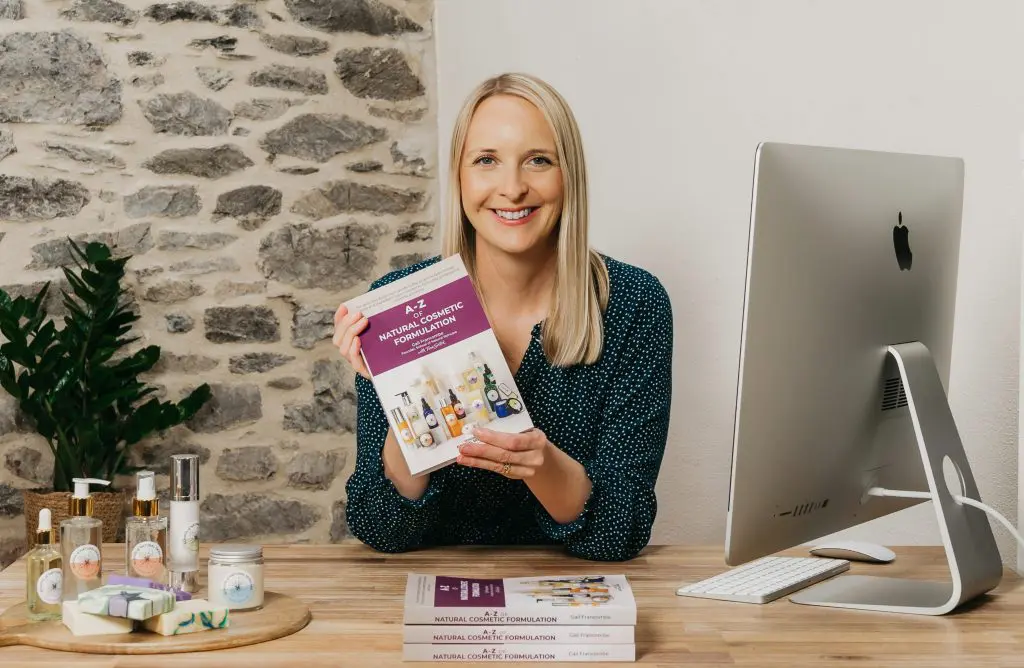
A-Z of Natural
Cosmetic Formulation
A digital copy of our international bestselling book is a definitive guide to the essential terminology, theories, and ingredient types needed to formulate professional cosmetic products.
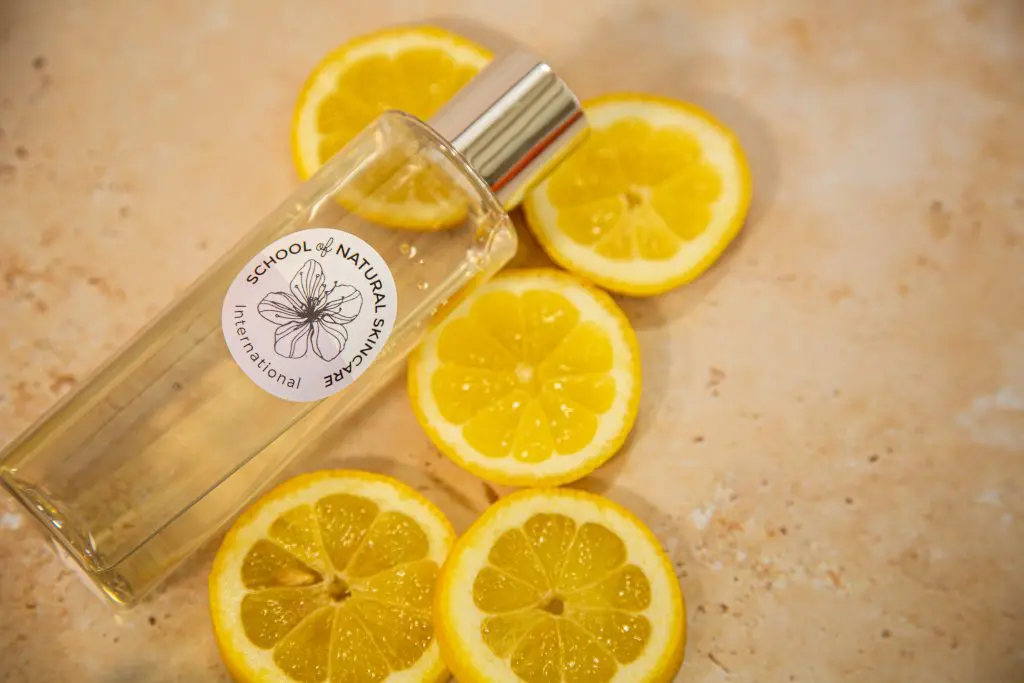
Formulating Face and Body Washes with Natural Surfactants
Learn about the science of surfactants and how to formulate two popular surfactantbased products: face washes and body washes.
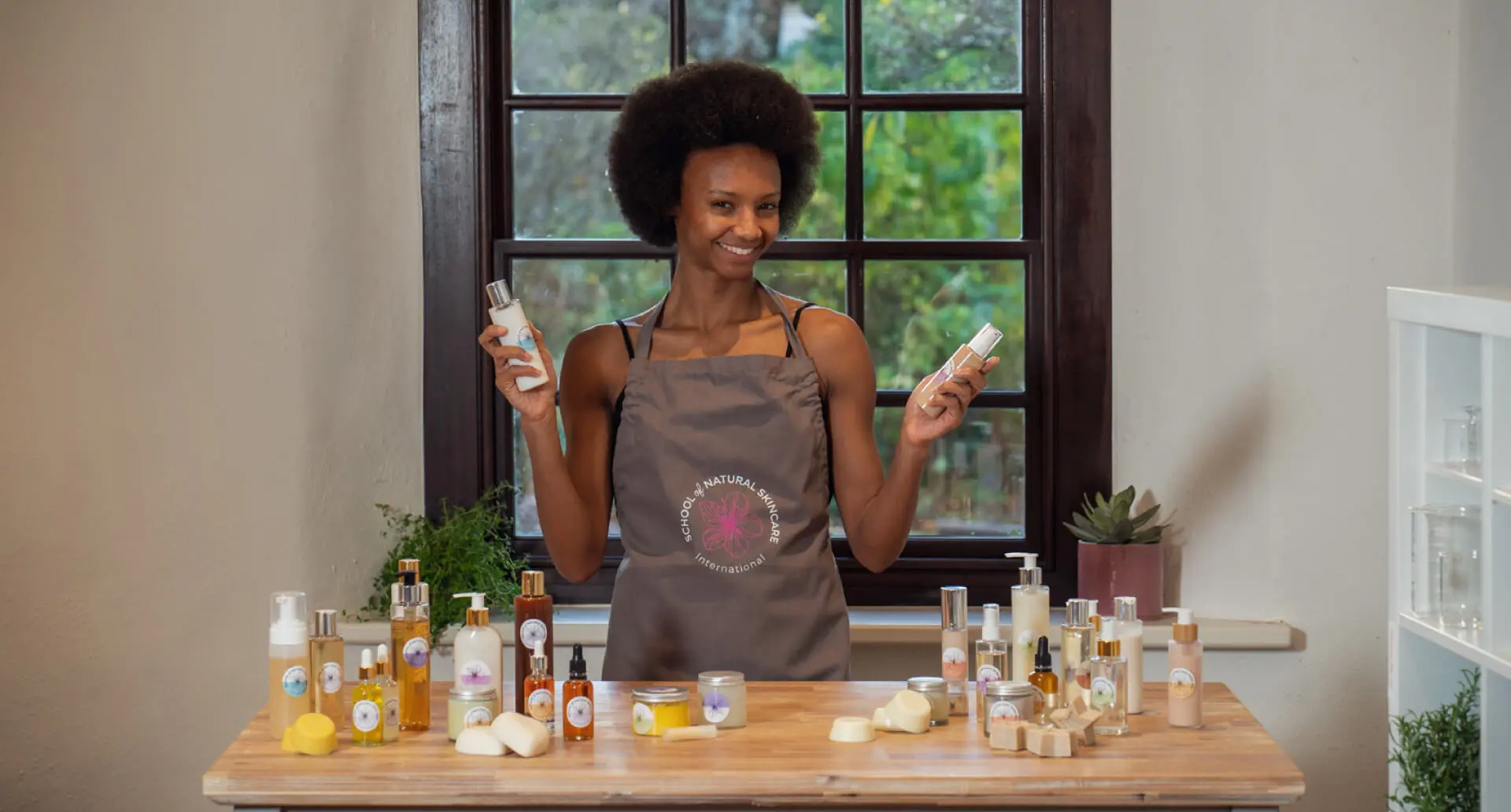
Ready to become a professional-level skincare formulator?
Enrollment is now OPEN
Join the Spring 2025 Cohort!
Plus, Enroll Before Midnight on Monday 31st March To Get 9 Bonus Classes for FREE!
- Craft Your Natural Skincare Brand in 5 Days
- Guide to Attending Cosmetic Conferences and Trade Shows
- How to Price Your Cosmetic Products for Profit
- Digital Copy of the International Bestselling Book A-Z of Natural Cosmetic Formulation
- Formulating with AHAs and BHAs
- Formulating Face and Body Washes with Natural Surfactants
- Masterclass 1: Unlock the secrets to preserving your skincare formulations naturally
- Masterclass 2: How to formulate hydrating toners, mists and gel-serums - the professional way
- Masterclass 3: Formulate natural skincare with potent actives and botanical extracts
Here’s what you get:
- Online course: Value $1250
- Tutor support: Value $500
- Live learning sessions: Value $500
- Community membership: Value $500
- 9 Bonus classes: Value $885
Total value:
$3635
All included
Enroll now for just:
It’s easy to get started
Choose your preferred payment option below and get immediate access to our online classroom.
Pay in full
Instant access to the
whole course for
US $1250
Access the entire course
immediately, along with three
bonus resources.
or
Installments
Four monthly
installments of
US $375
Spread your investment over four months, with new course material available monthly* and three bonus resources.
*A full breakdown of the release schedule can be found in the FAQ section of this page
We accept all major debit and credit cards and Paypal
By joining the course you accept our terms and conditions found here.
We open enrollment for the Diploma in Natural Skincare Formulation several times a year.
Want to be part of our next student cohort?
Join the waiting list and you’ll be the first to hear when enrollment opens.
While you are waiting we’ll send you exclusive formulating tips and give you priority access to course enrollment.
Join the waitlist
Bundle Offer
Join our Natural Haircare and Skincare Formulator Program
Save $250 and get four FREE classes
How incredible would it feel to build a natural beauty brand with skincare and haircare products too?
You can do just that with our Natural Haircare and Skincare Formulator Program.
You get access to our Diploma in Natural Skincare Formulation and Diploma in Natural Haircare Formulation to continue your exciting adventure as you extend your skills, become a confident natural skincare and haircare formulator, and realize your dreams of launching your own beauty brand.
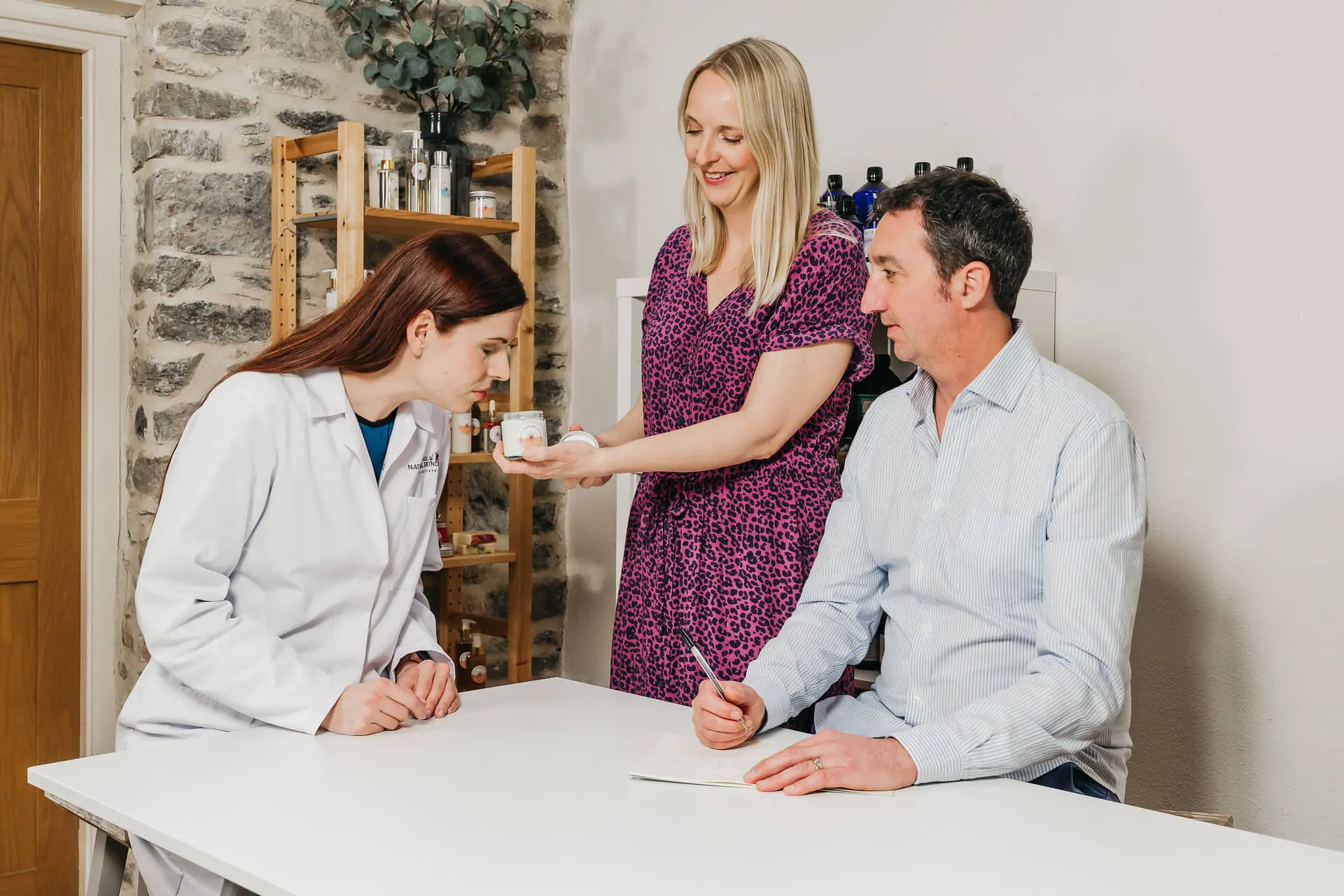
Plus
Get four bonus classes FREE
1

Formulating with AHAs and BHAs
2

Formulating Face and Body Washes with Natural Surfactants
3
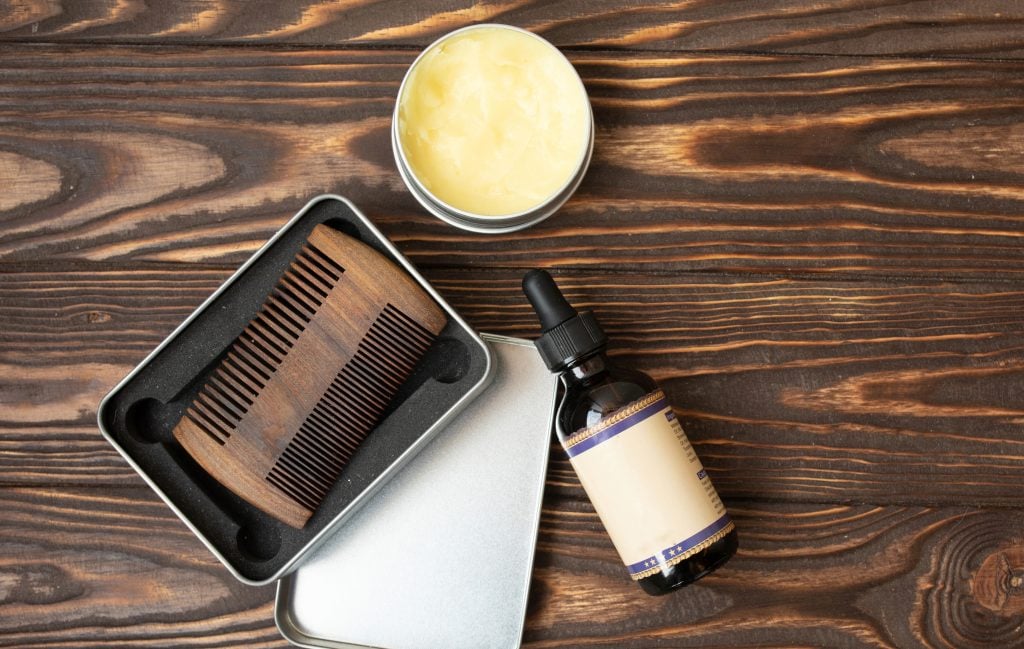
Men’s Facial Hair Products
4

Digital Copy of the International Bestselling Book A-Z of Natural Cosmetic Formulation
1

Formulating with AHAs and BHAs
2

Formulating Face and Body Washes with Natural Surfactants
3

Men’s Facial Hair Products
4

Digital Copy of the International Bestselling Book A-Z of Natural Cosmetic Formulation
Read the full details of the
BUY THE BUNDLE AND SAVE!
Enroll in the Natural Skincare and Haircare Formulator Program today
Here’s what you get:
- Two online courses: Value $2500
- Tutor support: Value $1000
- Live learning sessions: Value $1000
- Community membership: Value $500
- Bonus classes: Value $400 +
Total value:
$5400+
All included
Enroll now for just:
Pay in full
Instant access to the
whole program for
US $1997
Save $250 compared to enrolling on both courses separately. Plus, get four bonus classes for free.
or
Installments
Six monthly
installments of
US $397
Spread your investment over six months, with new course material available monthly and four bonus classes.
We accept all major debit and credit cards and Paypal
By joining the course you accept our terms and conditions
Hear what students are saying
The courses provided a scientific approach that changed everything.
- Wendy Rosky,
- USA
Before joining the School of Natural Skincare, I struggled with DIY recipes and found formulation difficult. I wanted to create natural skincare using locally sourced materials without harming nature. Now, I can confidently create skincare products. The worksheets were especially helpful in guiding my formulations. Thank you for changing my perspective on natural skincare!
- Wendy Rosky,
- USA
My passion has been reignited - I feel confident creating my own formulations!
- Maryann McKenzie,
- UK
I struggled with understanding preservative systems, ingredient compatibility, and stability issues. This course provided invaluable knowledge on how ingredients work together, allowing me to confidently formulate independently. The example formulations and videos were especially helpful. Every module was packed with engaging information.
- Maryann McKenzie,
- UK
Natural skincare has always been a hobby, but I wanted to take it further.
- Rebecca Abrahams,
- Australia
This course taught me how to create reliable formulas, using simple explanations and clear steps for percentages and scaling. I struggled with formulating and was confused about ingredient usage and consistency. The support from tutors and fellow students was invaluable. Now, I feel confident and informed in my formulation journey!
- Rebecca Abrahams,
- Australia
The School of Natural Skincare has been transformative for me.
- Krunalo Kalpesh Gorsani,
- UK
I took this course to understand the ingredients in my products and learn proper formulation instead of relying on YouTube. I initially struggled with ingredient knowledge and product creation. Now, I confidently make natural and organic products, experimenting with new formulas. The course’s blend of reading material, videos, and hands-on practice was invaluable. I’m excited for more!
- Krunalo Kalpesh Gorsani,
- UK
Top FAQs
Yes! The Diploma in Natural Skincare Formulation is accredited by the CPD (Continuing Professional Development) Certification Service. You can read more about our accreditations here
Yes! The course is hosted inside an easy-to-use online classroom. It is designed to be taken from home from anywhere in the world. The products we make meet global quality and safety standards. We’ll provide information on ingredient suppliers in many different countries and will guide you to the relevant cosmetic regulations in many countries around the world, too. We have students in over 150 countries so you’ll be joining a thriving global community.
We are an international school with students worldwide. US dollars are the most widely recognized and accepted currency. You can check the exchange rate for your local currency using exchange rate sites such as xe.com. Either your bank or PayPal will exchange the enrollment fee for your local currency when you join.
At the end of the course, there are several assignments for you to complete and submit to us to be marked personally by our cosmetic chemists. They will provide personalized feedback and guidance if any corrections are needed. Your end-of-course completion certificate will be issued upon successful completion, and you will be the proud holder of our Diploma in Natural Skincare Formulation!
You have access to the course within the online classroom for 18 months, so have plenty of time to study. You can download the course textbooks for lifetime access. You can renew your course enrollment for a small fee, which will also give you additional time to complete your assignments, further access to the tutor Q&A and any updates to the course made during this time.
The course is a self-study, self-paced course, so you can study at a time that suits you and complete the course as quickly or slowly as you wish. The lessons are available for you at any time.
To enhance your learning, we provide tutor-led live learning sessions throughout the year, which are optional to attend. You’ll receive plenty of advance notice about when these are happening, and if you can’t attend live, you can enjoy the recording at a convenient time.
Yes, the Diploma in Natural Skincare Formulation is suitable for beginners and formulators with some experience. Joining the course ensures that you learn the correct way to design and create products from the start, so it is a great way to begin your journey with formulating skincare products!
It’s important that you feel supported during your studies with us, and several avenues of assistance are available to you.
Technical/administrative help
Our customer service team is on hand if you require help with technical or administrative matters.
Tutor support and feedback on assignments
To provide you with the best support, we have experienced, professional cosmetic scientists on hand to answer your questions each week in the Tutor Q&A. We also run live tutor-led learning sessions throughout the year where you can deep dive into specific topics from the course.
At the end of your course, you will submit assignments to us that will be marked by one of our professional formulators. You will receive helpful feedback on your assignments, including any corrections that need to be made, so you can feel confident in the quality of your formulations.
Peer support
When you enroll on a course with us, you receive an invitation to join our Student and Graduate Community (hosted on Facebook), where you can meet and spend time with your student peers. We have students and graduates in the group from all over the world! You can ask questions, discuss formulations and feel part of a community as you progress through your studies.
Promotion of your beauty brand
If you already have a beauty brand or you establish a new brand after your studies, we can help you by promoting your brand to our vast, international audience! You’ll be invited to take part in an interview and have a feature written about you and your brand, which we will share with hundreds of thousands of our followers, by email and across social media. This is the perfect opportunity to start marketing your business and gain your own following.
It typically takes students 70-150 hours to complete the Diploma in Natural Skincare Formulation. The amount of time it will take you will depend on how much practical formulating you choose to do, so you may wish to spend more or less time than this. Most students complete the course within six to 12 months. As it is a self-paced course, you can complete it at a speed that suits your schedule.
A variety of formats are used including comprehensive and beautifully designed course textbooks (provided as PDFs), workbooks and worksheets, video lessons, video demonstrations, quizzes and activities.
To get started you can use some basic kitchen equipment that you use solely for the purpose of cosmetic making. Here is a list of the equipment that you should consider using:
- Protective clothing.
- A water bath or hot plate for a source of heat.
- Heat-proof glass lab beakers.
- Two thermometers.
- A stick blender (immersion blender).
- Digital scales.
- Pipettes/spoons/spatulas.
- pH strips (or meter).
- Sufficient packaging.
We have a blog article and video that you may find useful on the equipment you need to get started: The equipment that you need for making natural skincare products at home.
We go into much more detail about the equipment you need in the Diploma in Natural Skincare Formulation.
If you want a more professional lab setup, you can purchase professional pieces of equipment, which we can advise you about when you join the course. This is not necessary, however, as in many cases kitchen equipment is more than adequate.
As part of the course, you receive a comprehensive global supplier list featuring hundreds of cosmetic suppliers, many of which deliver internationally.
We also have a smaller supplier list on our website you might want to look at in the meantime: Recommended cosmetic raw material suppliers
The majority of ingredients used are available in most countries around the world. In some cases, if you wish to use specialist ingredients (such as emulsifiers and preservatives), you may need to order from overseas suppliers.
The Certificate in Making Natural Skincare Products is a short beginner’s course aimed at hobbyists that teaches you how to make products using lovely natural ingredients following our recipes. The Diploma in Natural Skincare Formulation teaches you how to formulate or design your own unique products and make them to a professional standard. The course contents are greater and more in-depth and take your skills and knowledge to a more advanced level.
If you are committed and passionate about making professional-grade natural skincare products and your goal is to formulate products from scratch, understand in more detail the science of cosmetic formulation, use more advanced ingredients and/or sell your products, then we recommend the Diploma in Natural Skincare Formulation.
If you want to dip your toe in and try making a few skincare products as a hobby, then our Certificate in Making Natural Skincare Products is the right choice to begin with.
Both courses can be taken as a beginner, so which one is right for you is more about where you want to end up than where you are starting from.
We have written an article that helps explain this further: Choosing between our skincare Certificate or Diploma – which course is right for you?
If you choose to spread the cost of your course by choosing a payment plan, you will not receive all of the course content in one go. Instead, each time we receive your monthly payment, the next installment of your course will be released according to the following schedule.
Month 1 (immediately after enrolling): Modules 1-4, plus A-Z of Natural Cosmetic Formulation.
Month 2: Modules 5-7.
Month 3: Modules 8-11.
Month 4: Modules 12-14, plus 2 bonus classes.
What does the Diploma in Natural Skincare Formulation course cover?
The Diploma in Natural Skincare Formulation covers all areas of skincare formulation.
- Formulate your own professional skincare range using a wide range of natural, organic and/or vegan ingredients aligned with your values for different skin types, tones and concerns.
- Be clear on your brand values and how you want your natural skincare brand to look and feel.
- Understand the science behind skincare products and the chemistry of cosmetics.
- Formulate products safely and correctly to meet compliance and regulation standards.
- Be able to set up your home lab, develop your lab skills and carry out good manufacturing practice (GMP).
- Know how to preserve skincare effectively and increase product shelf-life.
- Be confident and empowered with your new knowledge and skills to take your products to market.
The course also covers everything you need to consider when building a brand, including crafting your vision and values, defining your target audience, and creating a natural skincare product range customized to specific skin tones, types, or concerns.
Who is the Diploma in Natural Skincare Formulation course for?
The course is suitable for beginners and those with some knowledge who want to learn professional skincare formulation skills. It’s perfect for those who want to make products for personal use or start their own beauty brand.
What can I do after completing the Diploma in Natural Skincare Formulation?
After completing the course, you can create skincare products for personal use or start your own beauty brand. You’ll have the knowledge and skills to formulate a wide range of skincare products.
Do I need prior knowledge or skills to enroll in the Diploma in Natural Skincare Formulation?
No, the course is designed for beginners and those with some knowledge of skincare formulation. We start from the basics and gradually move to more advanced topics.
Is the Diploma in Natural Skincare Formulation recognized internationally?
The Diploma in Natural Skincare Formulation from the School of Natural Skincare is a globally acclaimed course accredited by the CPD (Continuing Professional Development) Certification Service. It will equip you with the skills to formulate skincare products that meet global quality and safety standards.
Can I start a business after completing the Diploma in Natural Skincare Formulation?
Absolutely! Many of our students have successfully started their own beauty brands after completing the course. You can read more about them here: Graduate success stories.
What support do I get during the Diploma in Natural Skincare Formulation course?
You’ll have access to our team of experts who answer our tutor Q&A each week. You can also join our online student community and live learning sessions.
Explore our articles
Want to try before you buy?
Sample a selection of our course material inside our online classroom.

